Plant Profiles dive deep on one plant variety each month. They are meant to provide you with enough information to make good growing decisions. A desire to grow gorgeous flowers is one thing. However, discerning if a particular plant is right for you and your climate is a whole other ballgame.
My intention here is to give you as much practical information to make these decisions. However, I’m going one step further and taking you completely behind the scenes to share exactly what has worked for us as well. For this reason, Plant Profiles are broken up into what I’m calling the “Nuts and Bolts (N&B)” and “Behind the Scenes (BTS).”
If you haven’t already, please be sure to read the FFY Introduction to learn more about how Plant Profiles are organized.
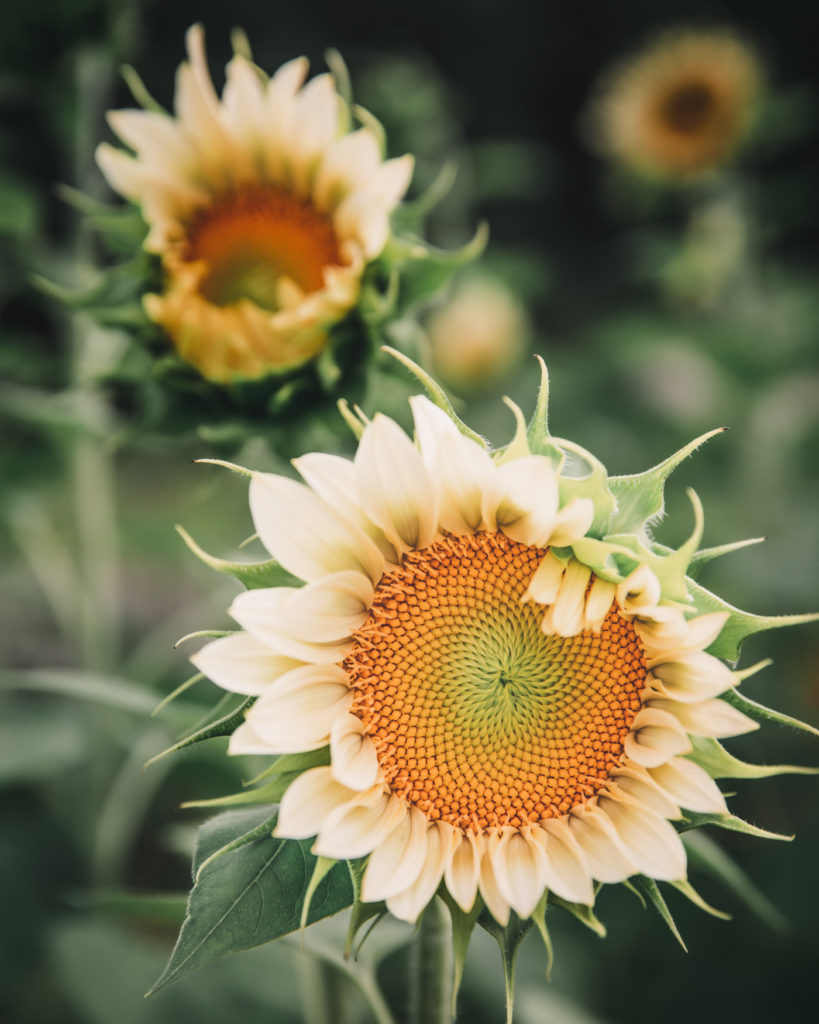
Primary Sources
The primary sources for the N&B portion come from:
- Postharvest Handling of Cut Flowers and Greens: A Practical Guide for Commercial Growers, Wholesalers & Retailers (Dole, Stamps, Carlson, et al).
- Specialty Cut Flowers, 2nd Edition, Revised & Enlarged (SCF): Industry standard for both new and experienced growers on the production of annuals, perennials, bulbs, and woody plants for fresh and dried cut flowers (Allan M. Amritage and Judy M. Laushman)
- Johnny’s Selected Seeds (Johnny’s): Johnny’s has been in the business for 50 years, with a research farm dedicated to finding the best seeds and tools for farmers and gardeners
- BOSTON Ornamental Terminal Prices. Specialty Crops Market News Federal – State Market News Service, USDA (as of 14-FEB-2023)
- Commercial Specialty Cut Flower Production: Sunflowers. Kansas State University (S. Stevens, A. Stevens, Gast, et. al.)
- The Latest Field-Grown Cut Flowers. (Dole, McCall, and Laushman)
- Studying the Market Potential for Specialty Cultivars of Sunflower Cut Flowers. American Society of Horticulture (Short, Etheredge, and Waliczek)
Zone Considerations
- Johnny’s Selected Seeds research farm is located in Zone 5a Maine
- Research conducted by North Carolina State University in Raleigh, Zones 7b/8a North Carolina
- Research conducted by Wyoming University in Laramie, Zone 4b Wyoming
- My farm, Petal Back Farm, is located in Zone 4b Wisconsin
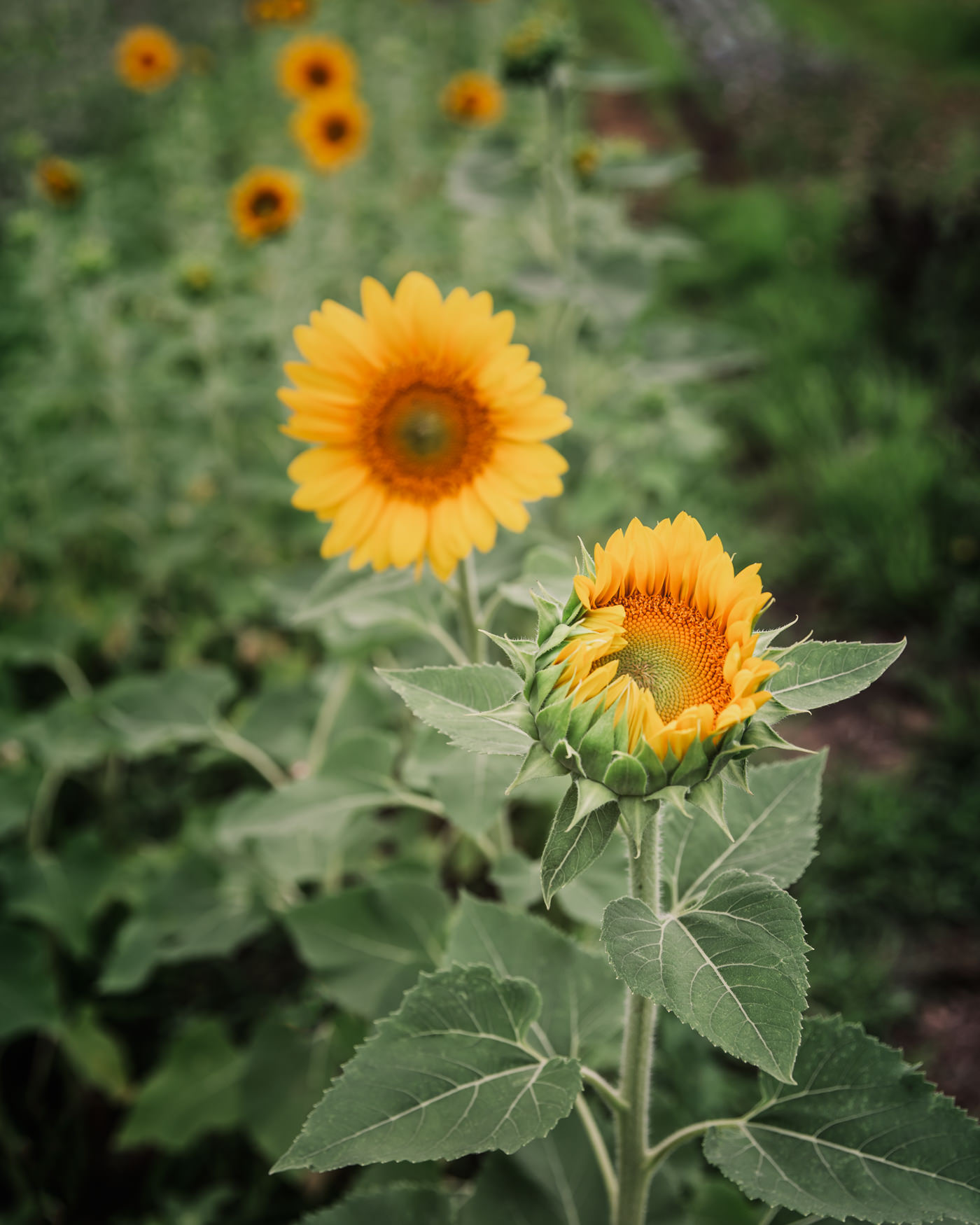
General Information: N&B
Latin Name Name: Helianthus annuus
Common Name: Annual sunflower
Origin: Western U.S., Midwest
Days to Maturity: Highly dependent on variety
Life Cycle: Annual
Spacing: Highly dependent on variety
Height: Highly dependent on variety
While love of sunflowers may not be what it was in the 90s, sunflowers are still a popular cut flower and for good reason. They are relatively easy to grow, seed is affordable, and they are a steady, reliable crop for the flower farmer.
According to Kansas State University (KSU):
Sunflower, or Helianthus, is native to North America. It was used by Native Americans, whose careful selection increased the seed size by approximately 1,000 percent in the last 3,000 years. They used sunflowers for food, dye and medicine, and extracted the oil for ceremonial body painting and pottery. The Hopi believe that when the sunflowers are numerous, it is a sign that there will be an abundant harvest. Early settlers grew sunflowers for food and garden decoration, and European explorers brought sunflowers along trade routes to Spain, Italy, Egypt, Afghanistan, India, China and Russia. The seeds yield a variety of products, ranging from snack food to soap, and the stems and heads can be made into paper or used for fuel. One English herbalist boiled and ate the buds with butter, vinegar and pepper, like artichoke.

General Information: BTS
Back when I was strictly a vegetable gardener, I would allow a small amount of space in my garden for sunflowers because of their cheerful and sunny disposition. They always treated me well. I always loved them.
Fast forward to the year we decided to start a flower farm. I foolishly let my attention slip away from my reliable sunny friends for sexier blooms like dahlias. What can I say? I’m a sucker for a bombshell.
I missed a few of my planned sowings, and oy, I paid for it. We had record days in the 90s that year, dahlias do not like that, and I was short on focal flowers . . . basically, dead in the water. From that season on, I promised myself I wouldn’t forget about my reliable pals. That’s why I’m dedicating an entire Plant Profile to them.
Sunflowers are a SUPER reliable crop that are easy to grow, fast to plant, and mature quickly. They also don’t take up much space. In a 4′ x 25′ bed, you can fit over 400 sunflowers at 6-inch spacing. Squeeze to 4-inch spacing, and that’s over 900 plants. We sell sunflowers for $20 / a bunch (though I will throw in extra if some are super small) or $1.50 / stem to florists. Even at 20% loss, that’s pretty decent revenue potential.
I also think that sunflowers can be used in higher-end designs with the unique colors. Bonus? Sunflowers typically get a lot of engagement on social media! The photo of ProCut White Lite at the bginning of this post was my 4th highest-engaged post in 2022. Not bad for the humble sunflower.
What I love most about sunflowers as a cut flower:
- Super reliable
- Easy to grow
- Long vase life
- Affordable to grow
- Low maintenance
- Easy to harvest
- Don’t take up a lot of space
- Cheerful
- Can be sold by the bunch
- Come in a variety of colors that are good for design
But every rose has its thorn, right? Potential shortcomings:
- I honestly cannot think of much
- They are thought of as a more-common flower, but the unique colors can potentially sway customers who do not prefer traditional sunflowers
- Not much to write home about in the fragrance category
Once we’re interested in a particular plant, it’s important to understand its native habitat when considering if we can or should grow it on our farm. Given that sunflowers are native to North America, this tells me they are widely adapted to our climate, but it’s my understanding that sunflowers are relatively easy to grow in *most* locations.
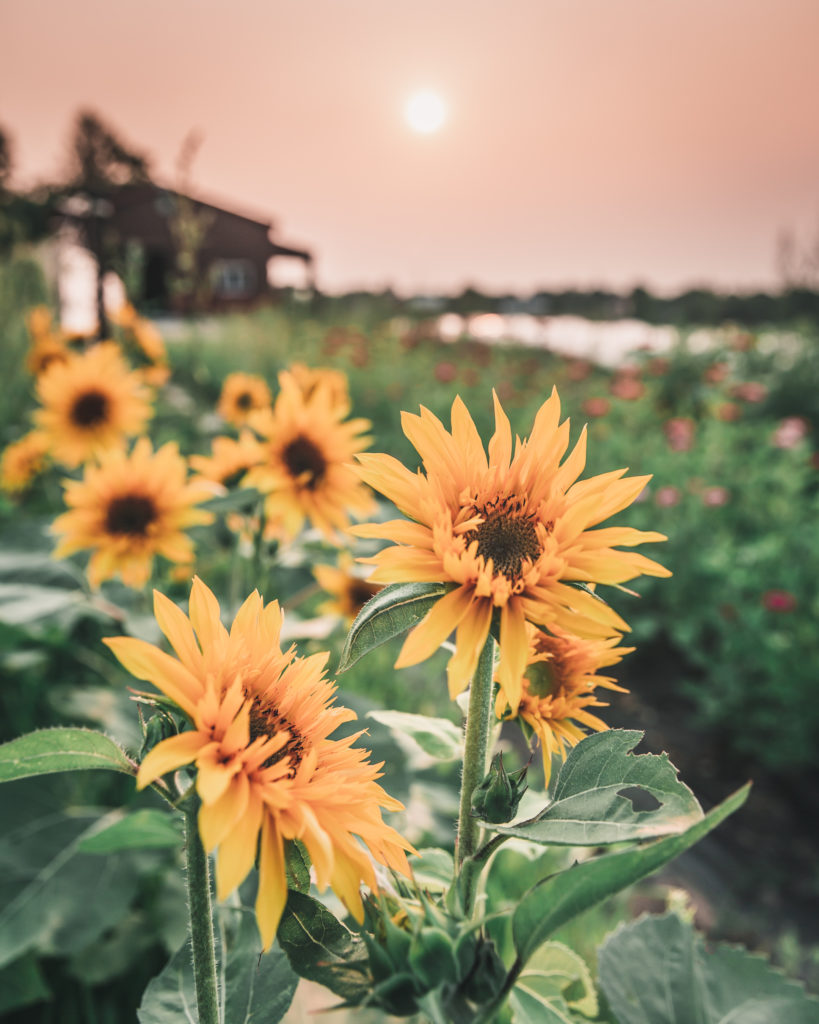
Two Primary Types of Sunflowers: N&B
It’s important to note that there are two primary types of sunflowers: Single Stem and Branching. These have very-different requirements throughout the growing process, so it’s important to make this distinction.
Single-Stem Sunflowers
Single-stem sunflowers are pollenless hybrids that produce a single stem with a single flower from one seed (aka, a one-hit wonder). For a continuous harvest, one must succession plant single-stem varieties every 10–14 days. They are quick to bloom, needing just 60 days from seeding date to reach harvestability. They can be spaced close together (6″ spacing produces smaller, bouquet-sized flowers), but you could space them 12″ apart to produce dinner-plate-sized blooms. They have strong stems and a long vase life, up to 14 days (Johnny’s).
Branching Sunflowers
Branching sunflowers produce numerous blooms over a long period of time, meaning they need less successions. They include many interesting colors and a majority the the doubles. However, they take longer to bloom (65 days or more), have shorter/weaker steams, and typically shorter vase life, with some as little as 5 days (Johnny’s). Branching sunflowers must also be spaced further apart (Johnny’s and Floret recommend 18″).
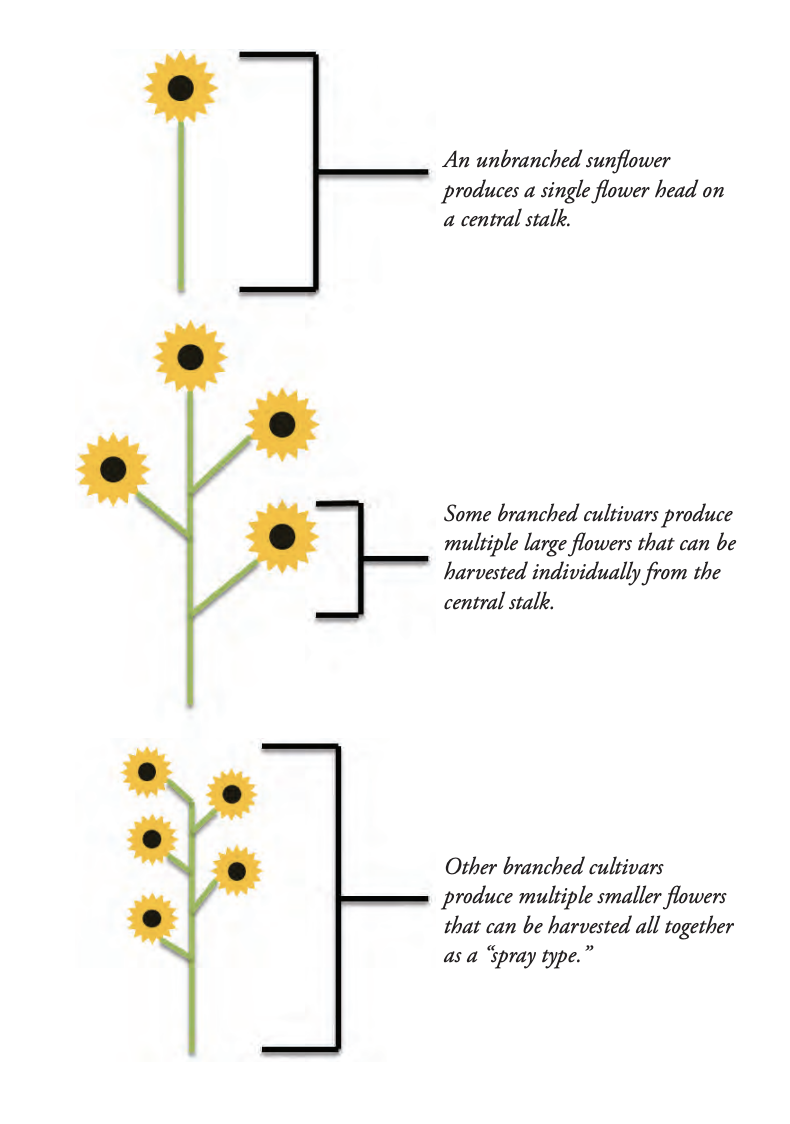
Two Primary Types of Sunflowers: BTS
While I’ll get into variety specifics later on, the majority of our sunflower production is single-stem varieties (namely, the ProCut series), but we also grow branching varieties for their fun colors and double forms (we do also grow a double, single-stem variety ‘Double Quick’ which blooms in 65 days).
Propagation: N&B
All plants are grown from seed. Most growers direct sow sunflower seeds, but they can be started in cell trays to push an earlier crop.
Direct Sowing
Johnny’s recommends direct sowing when temperatures are at least 50F (10C) and sowing 2–3 seeds at the spacing recommended for final flower size about 1/4 inch deep. Thin seedlings 7–10 days after emergence, leaving the strongest and sturdiest seedlings.
Transplanting
Johnny’s recommends sowing seeds into 50- or 72-cell trays 3–4 weeks before transplanting and maintaining temperatures at 70–75F (21–24C). Seedlings should not be held in cells for extended periods as they will become rootbound and/or leggy.
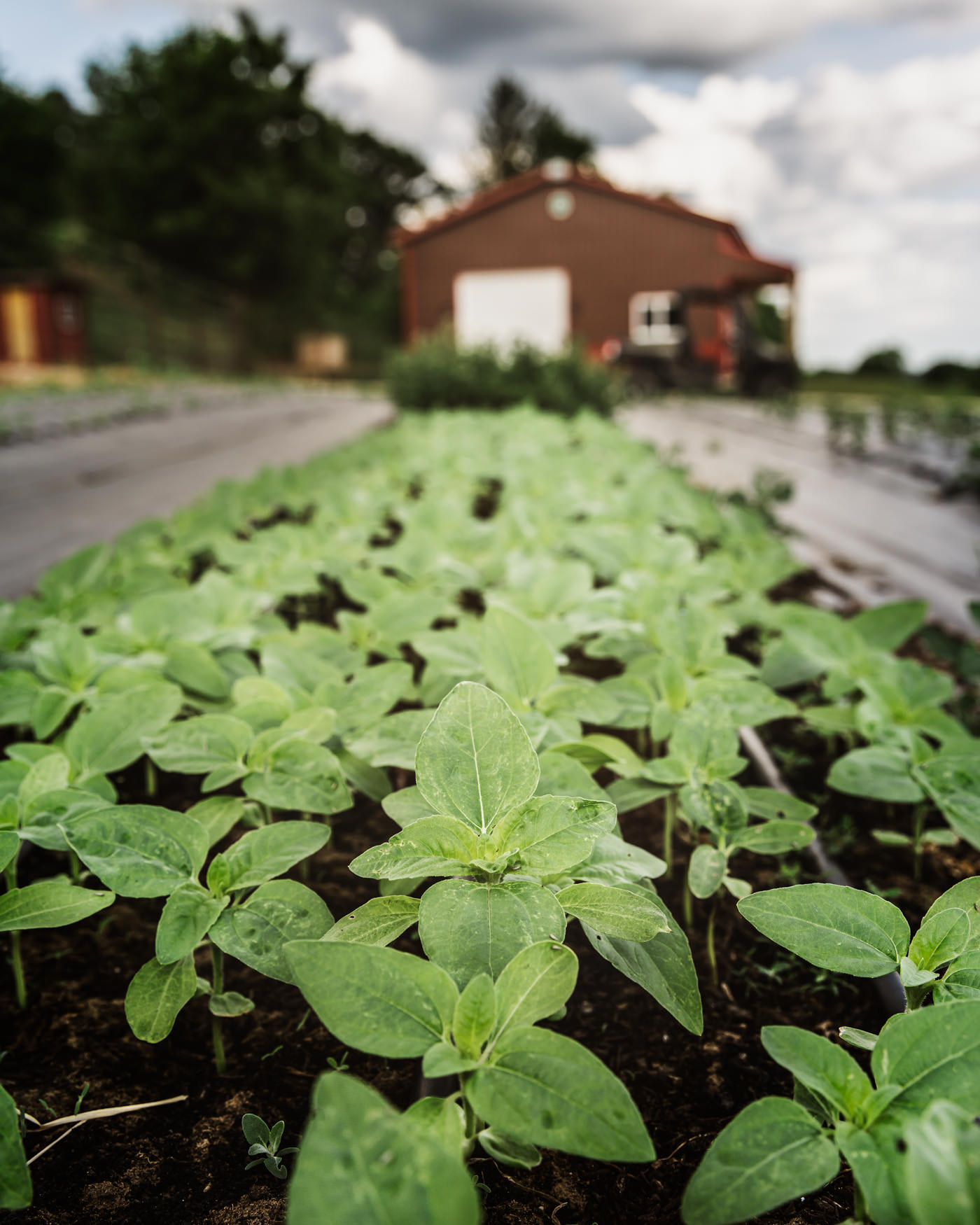
Propagation: BTS
We exclusively direct sow our sunflowers. In 2021, I did experiment transplanting a crop, but I don’t think it was worth the extra effort. Sunflowers take off when the temperatures are warmer and varieties like ProCuts mature quickly (50–60 days).
We direct sow single-stem sunflowers about ever 10 days until I can no longer stand it, usually from May to mid-July. I did sow a small crop in the high tunnel on August 7 last year, just to see if we could get a late crop. I thought they would take a bit longer to mature due to the cooler temps, but it must have been warm enough in the tunnel because we were able to harvest them for an October 12 sale, despite a killing frost at the end of September. Some years, we don’t get a killing frost until well into October, so I’ll probably try and push another later crop.
To sow single-stem sunflowers, I use the “bean” plate on the Earthway Seeder and tape every other hole to get the plant spacing a little better (this prevents seed from going in some of the holes). I’ll talk spacing more below, but I’m aiming for 4–6 inches. This isn’t perfect. Sometimes, I end up with multiple seeds in the seeder and the rows need to be thinned a little bit. I’d love to try out the Jang seeder, but it’s a splurge.
We direct sow branching sunflowers sometime after last frost (honestly, whenever I get around to it). I do these by hand at approximately 18-inch spacing.
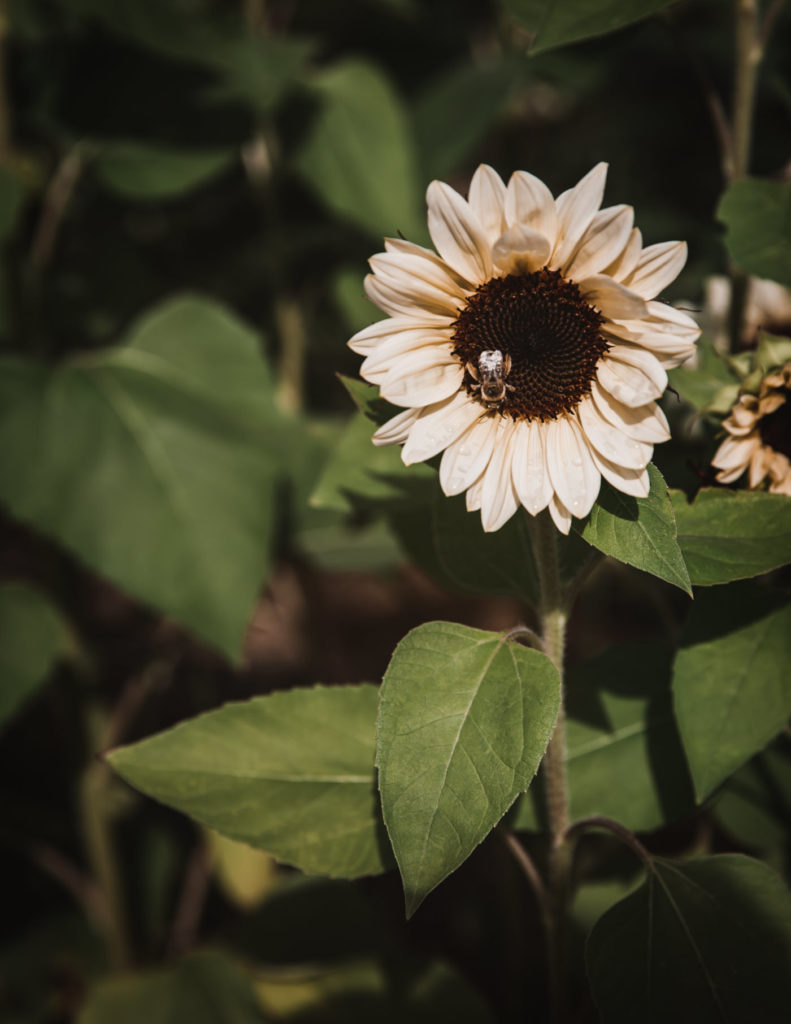
Environmental Factors: N&B
Photoperiod
While sunflower plants show a remarkable cultivar-dependent response to photoperiod, breeding has lead to many day-neutral cultivars (SFC).
In case you ever wondered why this matters, here is a wonderful explanation by Lynn Byczynski from Johnny’s website:
Many plant species have day-length triggers that determine when they grow vegetatively and when they initiate bloom. Plants that flower when the days are longer than 12 hours are referred to as long-day plants, and those that flower when days are less than 12 hours long are called short-day plants. Those that don’t respond to day length are called day-neutral.
Summer flowers are often long-day species, so they won’t bloom in winter even if you were to plant them in a tropical greenhouse. Rudbeckia ‘Indian Summer’ is a good example. It grows vegetatively when days are short and then, when days reach a certain length, it sends up tall flower stems. Plant it in spring, and you’ll get a great crop in summer. But if you plant it in summer, hoping for a fall crop, you will be disappointed. The plants will grow nicely, as the days get shorter, but they won’t flower — or if they do, it will be on short stems. They simply need longer days to produce long-stemmed flowers.
P.S., As Lynn nexplains, it’s actually the length of darkness rather than daylight that acts as the primary driver of plant growth and blossoming. But because this fact was discovered long after day length became widely used in horticulture, it’s still used today.
Lynn explains that most sunflower varieties are long-day species that will grow vegetatively during the short days of spring, then bloom when the days reach a specific length. If you want to grow sunflowers in early spring or late fall, when days are short, you need to plant day-length-neutral varieties.
Temperature
Warm temperatures result in faster flower development. Temperatures below 50F (10C) slow development significantly, while 65–75F (18–24C) is optimal (SCF/Johnny’s). The University of Wyoming notes that while temperatures below 50F (10C) delay flowering, sunflowers can survive temperatures down to 25F. But before you think this means you should sow earlier in the spring (like me, ha), for earlier flowering, SCF recommends it’s actually better to wait 2–3 weeks to plant in spring until temps warm up.
Site Selection
Choose a site that receives full sun in well-drained loam soil with a pH of 6.5–7.5.
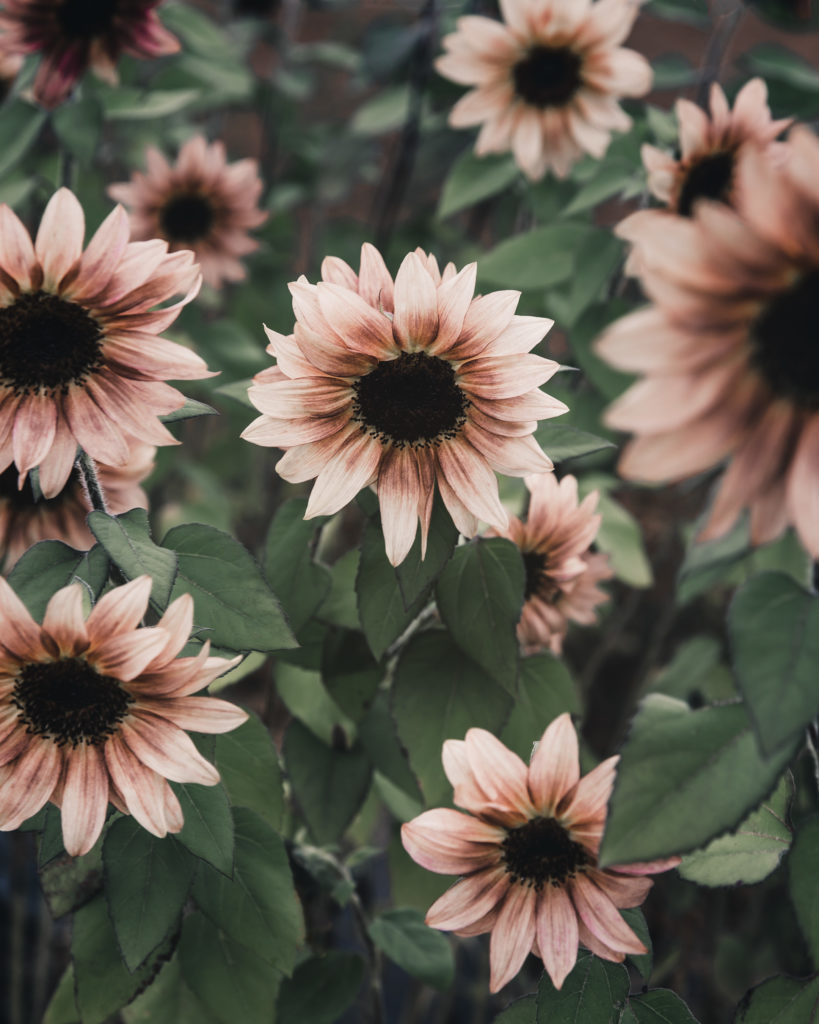
Environmental Factors: BTS
While I’ll discuss specific varieties later on, I keep things simple for the majority of our sunflower production and stick to the day-neutral ProCut series. I grow some branching varieties for the unique colors and forms, but these are really ancillary to our sunflower production.
So, full disclosure: my main goal when it comes to sowing sunflowers is to simply keep it simple and just Get. It. Done. I know if I sow every 10ish days, I’ll have a reliable crop, so I spend more of my fussing over premium crops, like dahlias and lisianthus. I do not stress too much about all of these environmental factors, though I do find them interesting.
I am someone who will simply sow early if the weather is OK-enough, figuring if I lose a sunflower succession to late frost it’s not the end of the world. However, now I’m slightly questioning my approach here, ha.
Something very odd did happen last year, and now I’m *wondering* if it had to do with this whole temperature thing. I planted ProCut Peach followed by ProCut Plum and ProCut Plum flowered first, and ProCut Peach flowered at the same time as an even-later planted ProCut White Lite . . . and I was baffled. Since ProCut Peach was new to me, I thought it maybe it had to do with this specific one (it still might, but the days to maturity are the same as all the other ProCuts). Is it possible that there’s something to this whole waiting to plant thing?
I’m guessing that those ProCut Peaches may have been delayed by cool weather. I’ve never experienced this before (usually ProCuts are pretty on cue). While I’ll still likely plant before our last frost date, I’m going to keep a closer eye on this.
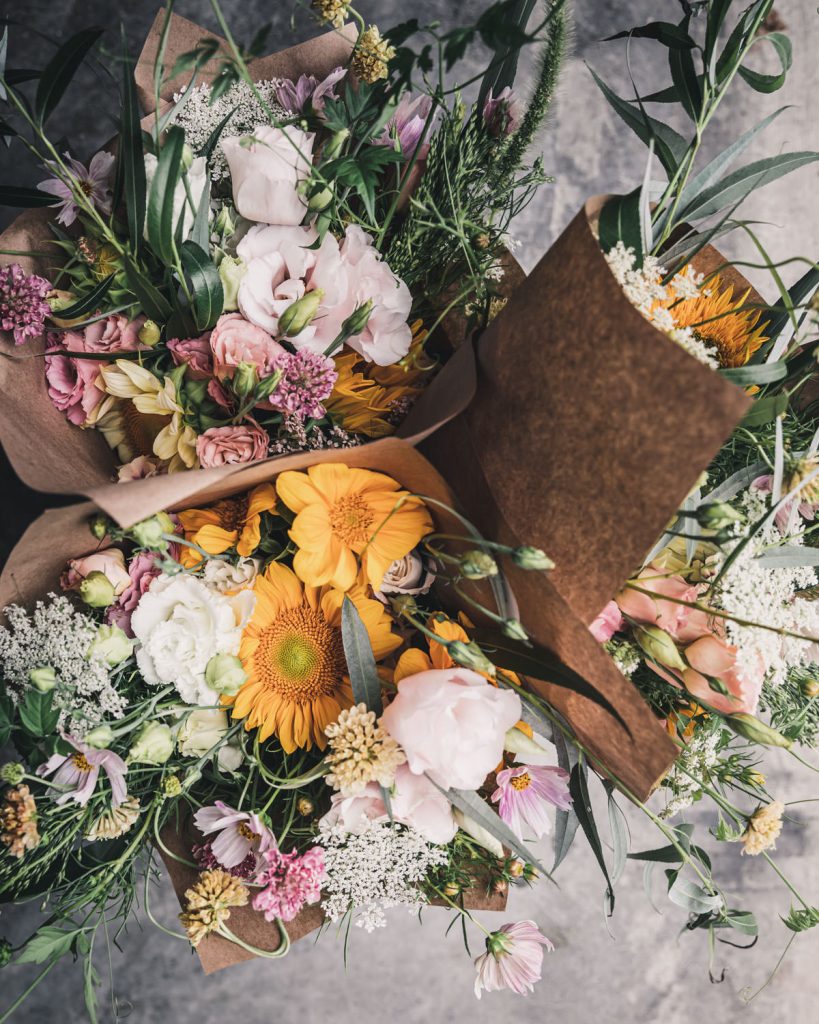
Field Performance: N&B & BTS
Plant Spacing: N&B
Single-stem varieties can be planted anywhere between 4–12 inches apart. The closer you plant them together, the smaller the blooms and diameter of the stems. Branching varieties should be planted approximately 18 inches apart.
Plant Spacing: BTS
I prefer smaller sunflowers and our florists prefer smaller sunflowers too. They are easier to work with. As I mentioned earlier, my janky sowing system means that my results are not always consistent, but I’m aiming for 4–6 inches for single-stem varieties. What this means is some are smaller than others, but this doesn’t bother me. Branching sunflowers are sowed at 18-inch spacing (by hand).
Successions: N&B
A season-long harvest can be achieved through succession planting. For single-stem varieties, one can accomplish this by either planting one variety several times throughout the season or planting multiple varieties with different maturity times. Below are three different planting schedules demonstrating this.
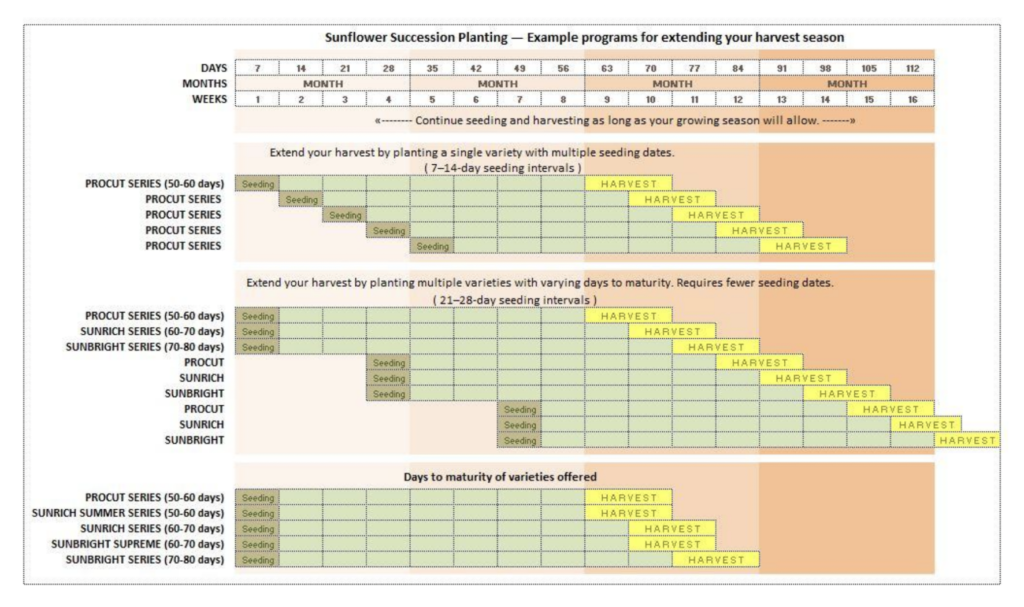
For branching sunflowers, succession-sow every 2-3 weeks and/or plant multiple varieties for continued harvest.
Successions: BTS
I’m sure I sound like a broken record at this point, but sunflowers for me are all about the KISS method (keep it simple stupid). I stick with the ProCut series and simply sow them every 10ish days (when I’m being a good flower farmer). I don’t succession plant branching sunflowers.
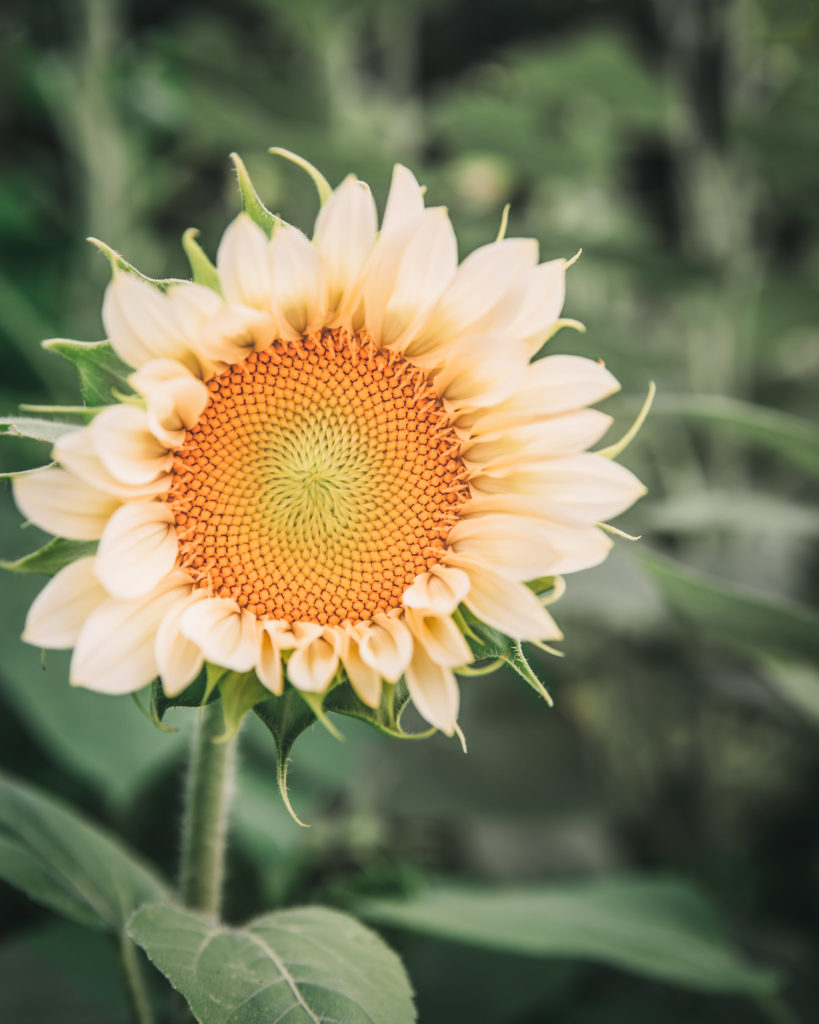
Support: N&B
While SCF mentions that support might be needed for some varieties, most growers do not provide support for their sunflowers. Perhaps if a grower is in a super windy location, support may be necessary.
Support: BTS
I have never provided support for our sunflowers. In my experience, their stems are strong, and we can have some pretty significant winds in the Midwest, depending on the year.
Nutrition: N&B
There’s actually a lot of conflicting information about fertilizer when it comes to sunflowers. While SCF says sunflowers are heavy feeders, Johnny’s states that sunflowers require little or no fertilizer to produce high quality stems and blooms. It’s worth calling out that Johnny’s states that excessive nitrogen, especially in summer, results in plants that grow too vigorously with abnormal flower shapes.
If soil is poor, Johnny’s recommends 20-5-30. The University of Wyoming recommends fertilization at 100 to 150 ppm N at each irrigation or 300 ppm N once a week. Trials in Laramie successfully cultivated sunflowers in a greenhouse and high tunnels using 0.02 ounces (about ½ teaspoon) of 15-9-12 slow-release fertilizer per plant. SCF recommends feeding plants 3 times per season. Either side dress with granular 10-10-10 or liquid feed of 20-5-30 at 200 ppm N with a complete soluble fertilizer.
If you have plants where buds are falling off or dying back, stems breaking, or leaves curling downward, you could have a boron deficiency (Johnny’s), though only a soil test can truly determine this.
Nutrition: BTS
I am sure that dialing in your fertilization game per crop is ideal, but we do not do that. We fertilize our fields organically based on soil tests, and we do not fertilize for each crop individually (though I may toss a little extra Nitrogen on my N-loving sweet corn). I have an eBook that outlines exactly how we do this. I’ve made that available for you here.
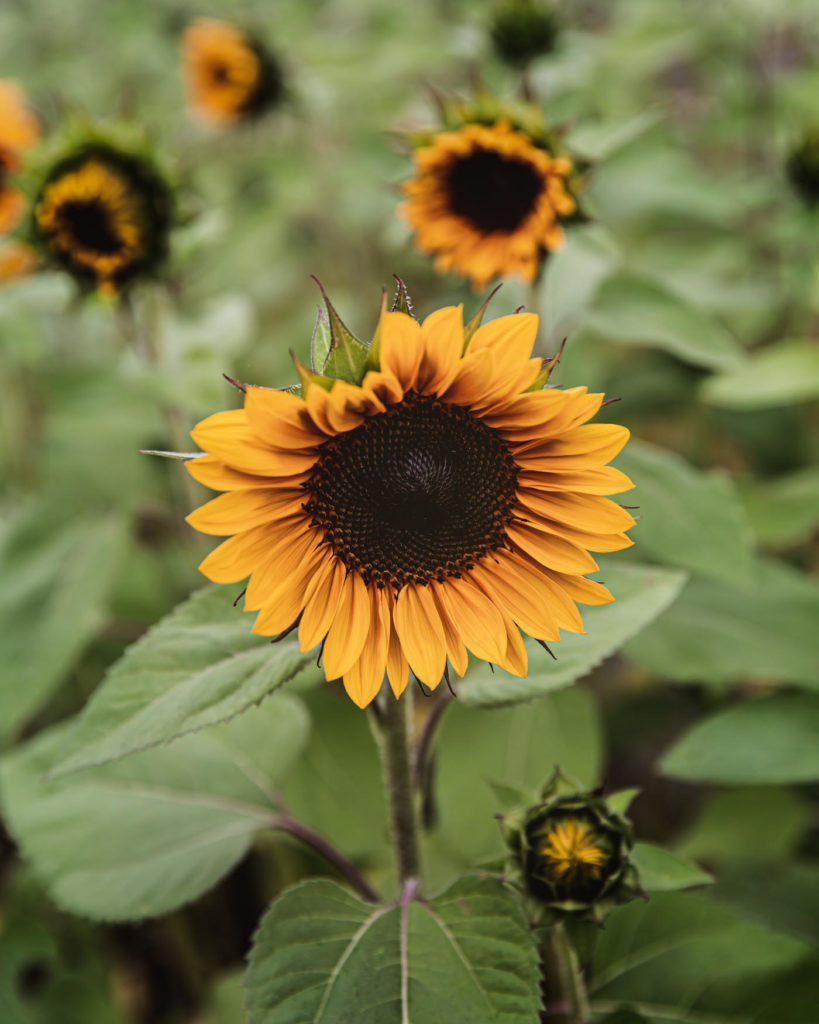
Drainage & Irrigation: N&B
Johnny’s recommends well-drained soil. According to the University of Wyoming, sunflowers require consistent irrigation, but oversaturation should be avoided to prevent stem or root decay. Frequent and extensive drying out of the growing medium can lead to delayed flowering and decreased stem length or, in extreme cases, flower deformities.
Drainage & Irrigation: BTS
At our farm, we have gossil-loamy sand, meaning that our soil is more sand than loam. It actually drains excessively to the point of leaching nutrients. Our biggest difficulty is keep plants irrigated, especially in dry spells. For this reason, we do have drip irrigation installed on all of our beds at the home farm.
Pinching: N&B
Do NOT pinch single-stem varieties (remember they only have a single stem that produces a single flower). Cultivars that are naturally basal branching do not need to be pinched (SCF). Johnny’s recommends pinching branching varieties to encourage branching and longer stems.
Pinching: BTS
I actually don’t pinch any of our sunflowers 🙂 I perhaps should experiment with the branching varieties, but I get busy, so I usually just end up cutting out the first flower deep. That said, SCF recommends pinching early (when plants have 4–6 leaf pairs) if longer stems are desired.
Bloom Period: N&B
Single-stem sunflowers will bloom as early as 60 days from when they are planted. Branched sunflowers will bloom as early as 65 days from when they are planted. It’s best to consult the days to maturity listed on the seed packet, but this will all be dependent on environmental factors.
Bloom Period: BTS
Assuming we sow May through July (with an August tunnel sowing), we have sunflowers July through September (with an October crop in the tunnel).
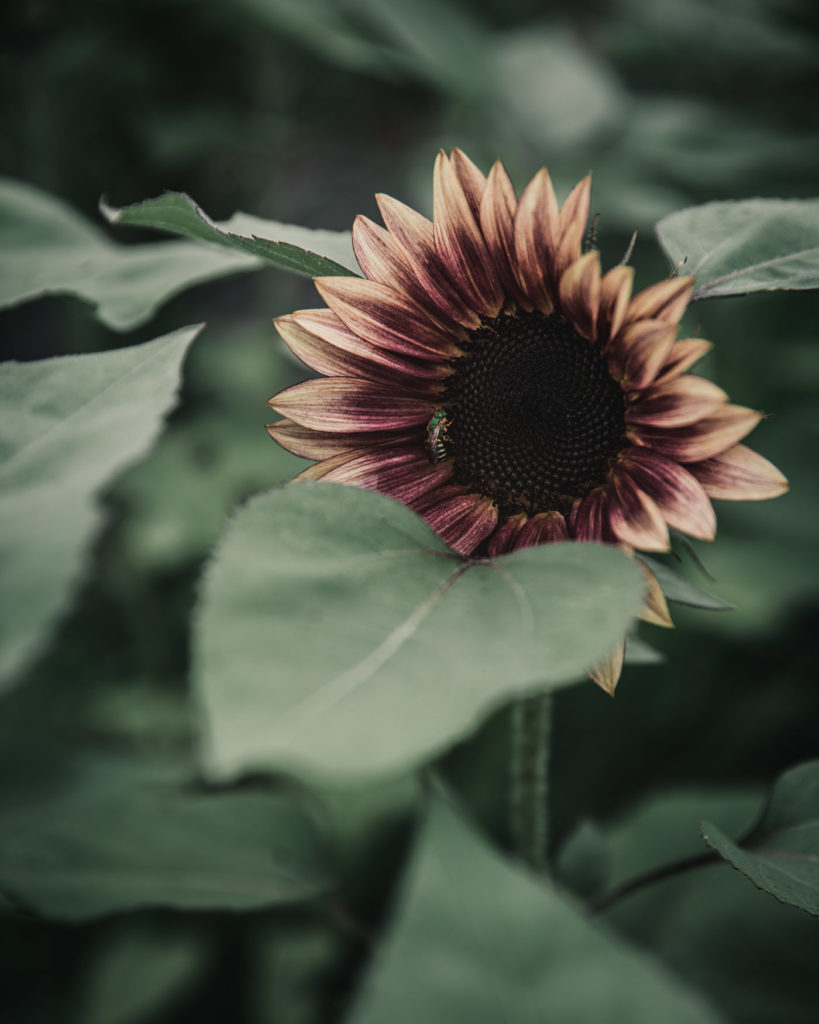
Harvest: N&B
Some growers have been successful in harvesting tight, when petals are barely visible; others wait until 1 or 2 petals lift off the disk, and some will wait until the flowers are almost completely open (SCF). If cutting at a later stage, the center of disk should still be tight, meaning that the very few rings of the tiny disk flower have started to open (Postharvest Handling). Interestingly, Postharvest Handling says that if lengthy cooler storage is anticipated, it’s actually best to cut flowers when they are more open than just 1 or 2 petals, as the cold storage may inhibit opening.
Harvest sunflowers in the morning, when the dew has dried but before temperatures warm (later in the evening also works). Cut at an angle at the desired length, and strip the majority of the foliage as they fade quickly. I wish I knew who to give credit for this, but some growers first strip all the leaves of harvestable blooms and then go back through and cut them. This can be more efficient for some growers, or a good way of indicating to new employees which stems can be harvested.
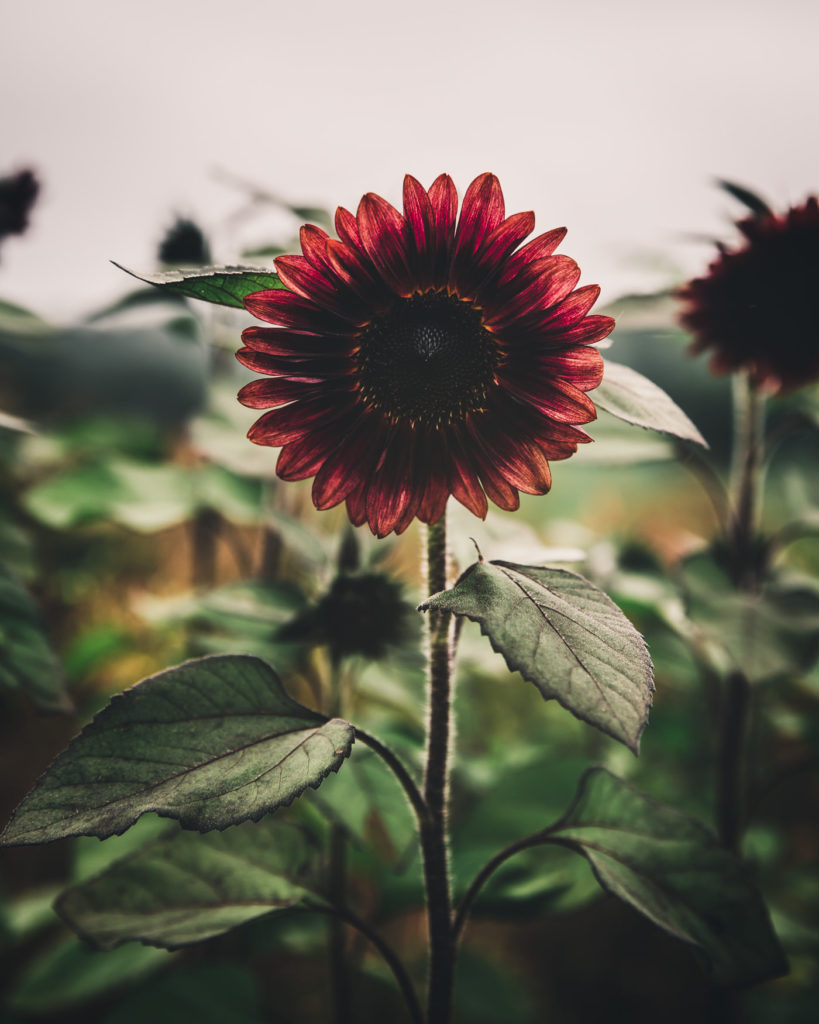
Harvest: BTS
Although the latter strip then snip method sounded intriguing to me (I tried it), I much prefer the snip and strip. It just feel like I waste time going back through looking for stripped stems, but it seems to work great for others.
For our weekly deliveries and florists, I aim to harvest when 1 or 2 petals lift off the disk, but I’m OK selling sunnies as long as they are harvested when the disks are still tight. Honestly, we grow way more sunflowers than we need, but they make great gifts and/or welcome bouquets for our AirBnB guests. If sunflowers are past their ideal harvestable point (or I don’t need anymore for orders), I simply let them go for the garden and wildlife. As I’m sure like many of you, I got into this biz because I love gardening and nature. I have zero issue growing flowers just for me, the birds, and the bees 🙂
You might be thinking: but most of them are pollenless, isn’t this a mean trick on the bees? While yes, they are mostly pollenless, they do still produce nectar and both pollen and nectar are needed by the bees! And if those pollinators visit regular sunflowers before the pollenless varieties, they will produce seeds, which always makes the birds happy. For me, it all contributes to the larger, diverse farm ecosystem as a whole.
And aside from the birds and bees loving them, they are always great for pictures for our website, newsletter, and social media! I often get DMs from new growers wondering how much to plant and being freaked out about growing too much and letting things go to waste. While I very-much believe you need to consider expenses and losses when it comes to business, I don’t think planting too much is automatically a “waste” or should be considered a total loss.
Assuming we’re using good growing practices, I believe these plants are good for the earth and that extra flowers can have many other purposes: feeding wildlife, donated to a nursing home, or repurposed for marketing material (we do all three here)!
Good pictures of beautiful flowers sell later harvests down the line. I try and be cognizant of what my customers want to see, so I am very intentional with my photos. As flower farmers, we know that photos of blown out sunnies are not going to customers. While a photo of a closed sunny might be good for educational purposes, customers usually want to see the flowers in all their glory. It’s what gets people excited!
So my two cents is don’t fret too much about flowers that get away from you or planting a little too much. Use them as opportunities to improve your surroundings, your community, and/or your business. I believe I heard David Dowling once say: If you are not growing more flowers than you’re selling, you’re leaving sales on the table.
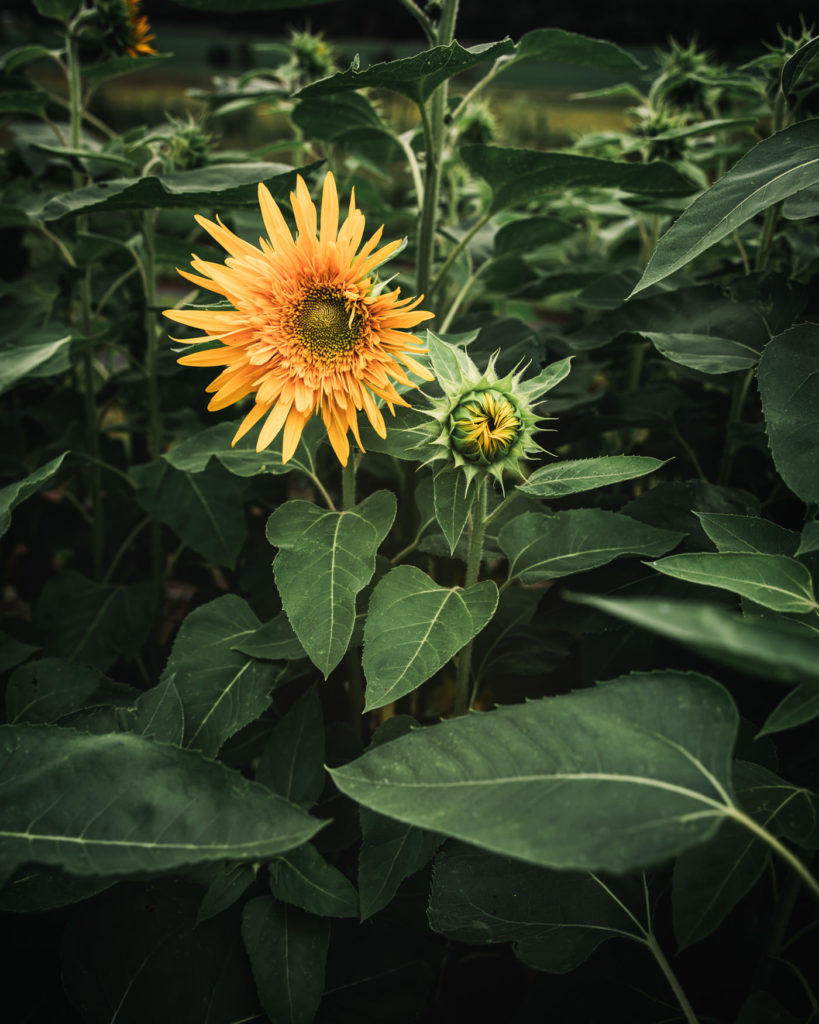

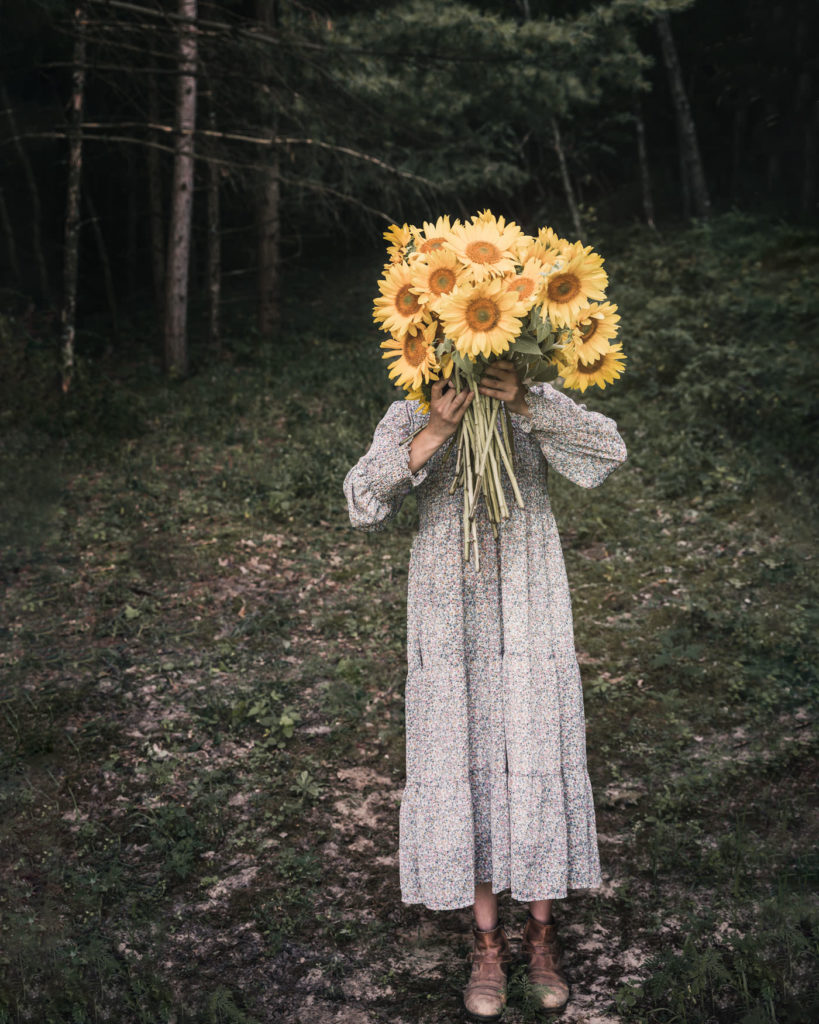
Post-Harvest Treatment and Storage: N&B
According to Postharvest Handling, sunflowers should be cut into and held in a commercial holding solution or acidifed water, as sunflowers benefit greatly from solutions with a low pH. They can be stored at 36–41F (2–5C) for up to a week. The University of Wyoming reports sunflowers can be held as low as 33F.
Trials conducted by North Carolina State University seem to back this up:
Field- grown flowers were harvested into tap water at the optimum stage of flower development. Stems were then sorted into four equal groups and placed in these treatments for the specified time and then placed into vases of deionized water:
- Hydrator only (four hours)
- Holding preservative only (two days)
- Hydrator for four hours followed by holding preservative for two days
- De-ionized (DI) water only (as a control)
Some of the results:
‘Sunburst Greenburst’ lasted seven to eight days and treatments had no apparent effect, while ‘Sunburst Panache’ lasted eight to nine days when held in water for two days, but lasted 10 to 11 days when held in a holding solution. ‘Helios Flame’ had a long vase life of 11 to 12 days and treatments had no apparent effect. ‘ProCut Brilliance’ lasted seven to nine days when held in water for two days, but lasted nine to 11 days when held in a holding solution. Vase life of ‘ProCut Red’ was also extended with the use of a holding solution from eight to nine days for water to nine to 10 days in a holding solution.
A Note on Drooping Heads
According to SCF, drooping heads indicates poor water transit to the flower, likely due to blocked stems. They suggest recutting and immediately plunging the stems in warm water reduces the tendency of some cultivars to droop.
If heads are drooping in the field, it could also be due to insufficient moisture (either too much or too little). It could also be because of harsh weather conditions, causing the plant to protect it’s reproductive parts (e.g., shielding pollen from excess rain). I find that some varieties, like White Lite, are simply more susceptible to this at times but we just anticipate that to be the case. I find this happens more often when we did not get around to putting irrigation lines on the sunflowers, leading me to believe the research is onto something.

Post-Harvest Treatment and Storage: BTS
For storage, I use Chrysal Holding Solution and store in the cooler around 38–40F (3–4C). Sunflowers are considered one of the “dirty flowers,” meaning they pollute water faster than other flowers and are also more sensitive to pollution. For this reason, I add a Chrysal CVBN tablet to harvest buckets to prevent bacteria in the stems and water.
Interestingly, it does not appear that studies indicate that hydrators are necessary or even beneficial for sunflowers. Yet, SCF notes that plunging stems in warm water to facilitate water transit could help drooping. I do have some varieties that occasionally droop, like ProCut White Lite, but I love her so much (as do our customers/florists), I just keep the droopy ones for myself. It’s not so significant that a control is needed, but a few experiments with hydrator or warm water might be interesting.
Please note: The use of traditional floral preservatives is not approved for organic use. If you are organically certified or transitioning to organic, you must check with your certifier before using any preservative.
While we personally choose to grow everything on the farm using organic methods, we are not certified organic. At this time, our customers have communicated that they value our growing practices, but also the long vase life of our flowers. We also supply a packet of flower food and heaven knows if I forget, our customers let me know about it, HA (literally, I legit get emails)! We choose to use these post-harvest methods to best meet the needs of our florists and customers. For us personally, it works, but only you know what’s best for you and your farm.
I also have zero affiliation with Chrysal. They are just often recommended and I stock up during Black Friday sales.
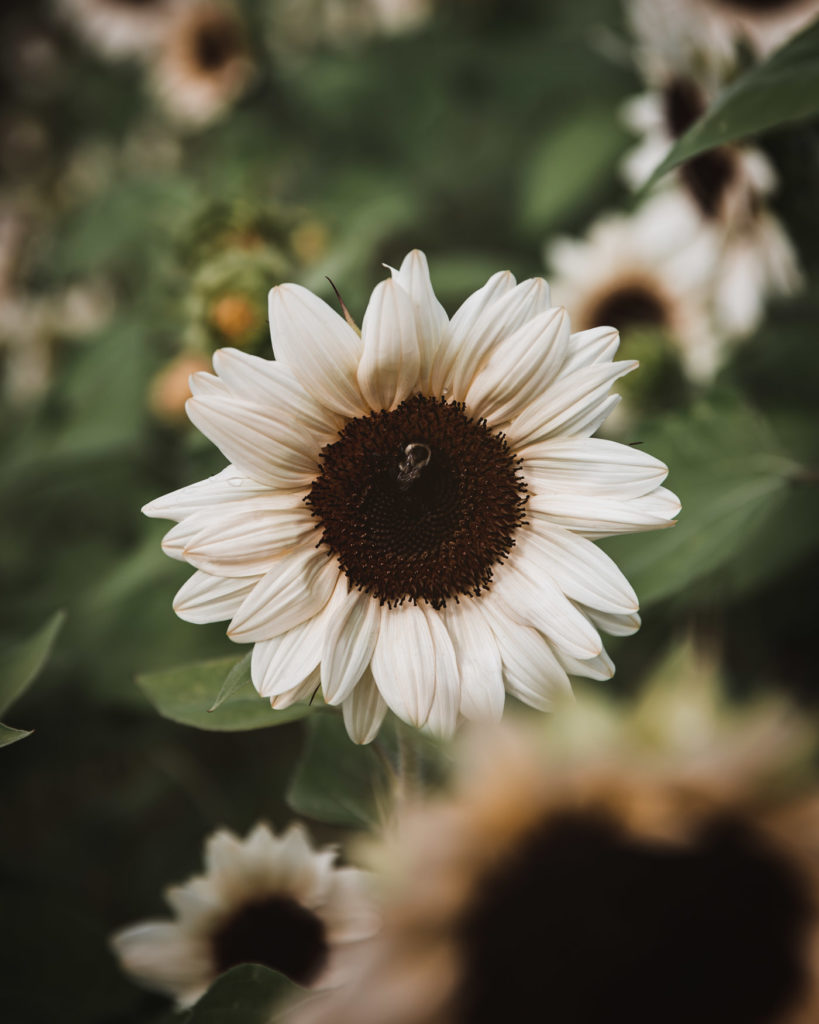
Pests & Disease: N&B
Pests
Aphids, thrips, tarnished plant bugs, caterpillars, cutworms, and grasshoppers are all pests that can affect sunflowers (Johnny’s, SCF). If you suspect one of these pests, Johnny’s has a Pest & Disease Control Comparison Chart on their website for their preferred control methods (and the majority are approved for use in organic production). For non-chemical controls, the use of beneficial insects such as lady bugs, lacewings, and minute pirate bug are also successful controls (Johnny’s).
With sunflowers, other pests to consider are animal pests, like birds, mice, and small rodents when seeds are direct sown or with newly planted seedlings (in our area, deer will also eat sunflower plants). Johnny’s recommends bird netting or Plantskydd. Electric fencing can be affective for deer.
Disease
Powdery mildew, downy mildew, leaf spots, rust, and stem rot can all impact sunflowers. Preventative measures include providing good air circulation, avoiding overhead watering (especially late in the day), removing and destroying infected plant material. For more severe disease pressure, refer to Johnny’s Pest & Disease Control Comparison Chart.

Pests & Disease: BTS
When it comes to pests and diseases, my honest answer is that I do very little. My general approach is to create as diverse an ecosystem as I can with various crops that hopefully draws in a host of wildlife, creating its own balanced ecosystem. My fear is that strong controls have negative impacts elsewhere. As Thomas Sowell once famously said, “There are no solutions. There are only trade-offs.” My hope is that any imbalance naturally dissipates as we increase diversity.
That sounds all fine and dandy, but this does not happen overnight and is not a solution for immediate issues. Nor are we without pests or diseases on our farm! When issues arise, I do my best to improve the situation in the least-harmful way possible (sometimes, that means nothing at all or, unforatunately, simply removing and disposing of the plant).
Our sunflowers occasionally get powdery mildew when it’s especially rainy, and the deer sometimes eat them. The deer decimated our sweet corn and beans, so we have thrown around the idea of an electric fence, but we’ll see.
Our biggest pest problem is Japanese beetles. I have introduced beneficial nemotodes and milky spore to the soil (as they are thought to eliminate at the grub stage), but Japanese beetles are super prevalent in the Midwest. If they are really bad, I just get a bucket of soapy water and knock em in.
The only other control we currently use is releasing ladybugs and lacewings into our high tunnel. Has it helped? Hard to say, but they stuck around last season (lacewings are cool, I keep trying to catch one with my camera).
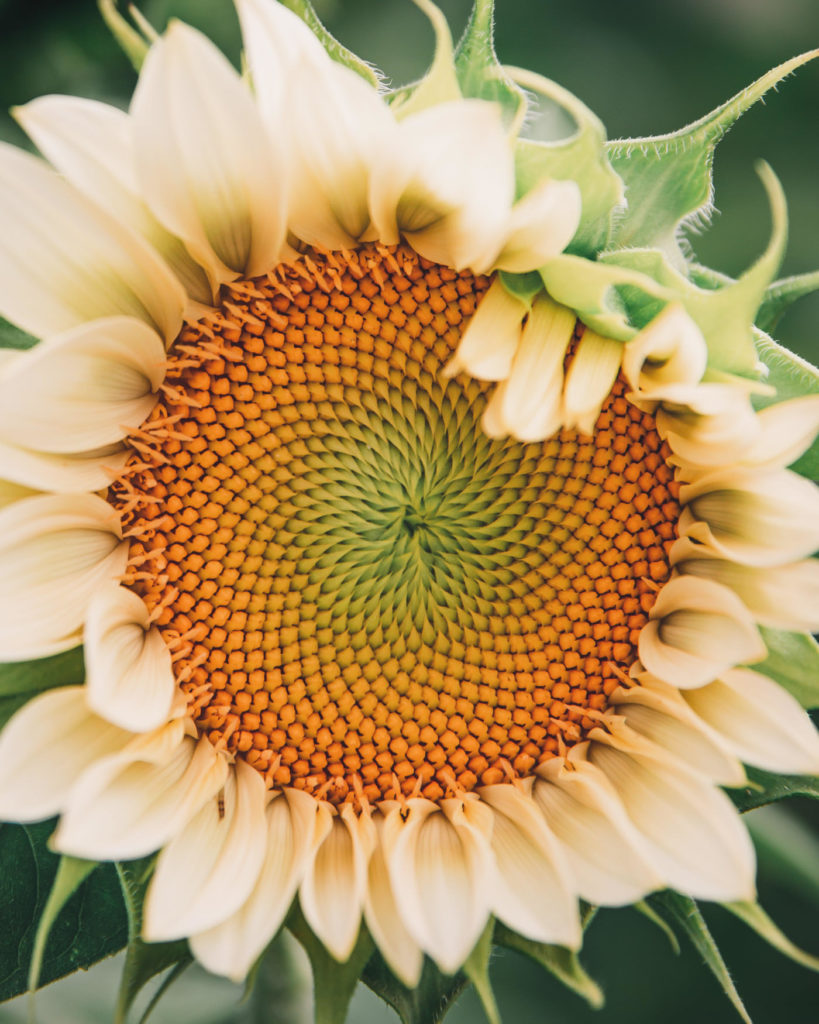
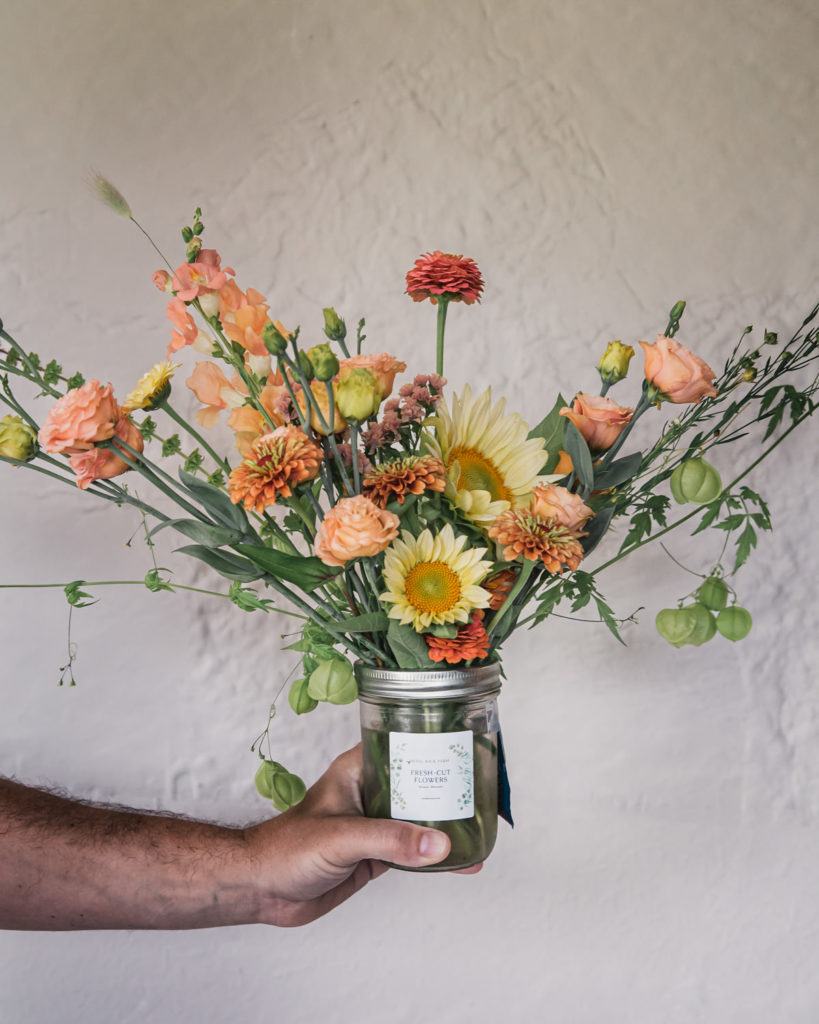
Variety Selection: N&B
According to Johnny’s, day-length neutral varieties or varieties listed for short days should be selected for growing early or late indoors. When it comes to single-stem varieties, they recommend the ProCut series for early and late production. There are SO many sunflower varieties. My suggestion is to browse Johnny’s and Sunflower Selection’s catalogues. Another great resource provided by Johnny’s is their Top 10 Single Stem and Top 10 Branching Varieties lists which can be found here.
Variety Selection: BTS
Below are all of the varieties we grow!
Single-Stem Sunflowers
With the exception of Double Quick Orange, we stick to the ProCut series: ProCut Gold Lite, ProCut Gold Lite DMR, ProCut Horizon, ProCut Orange, ProCut Peach, ProCut Plum, ProCut Red, ProCut White Lite, ProCut White Nite.
Branching Sunflowers
Black Beaty, Cherry Rose, Doppio Green Center, Ruby Eclipse, Panache, Terracotta.
Source
I source the majority of our sunflower seeds from Sunflower Selections, but also Johnny’s Selected Seeds.
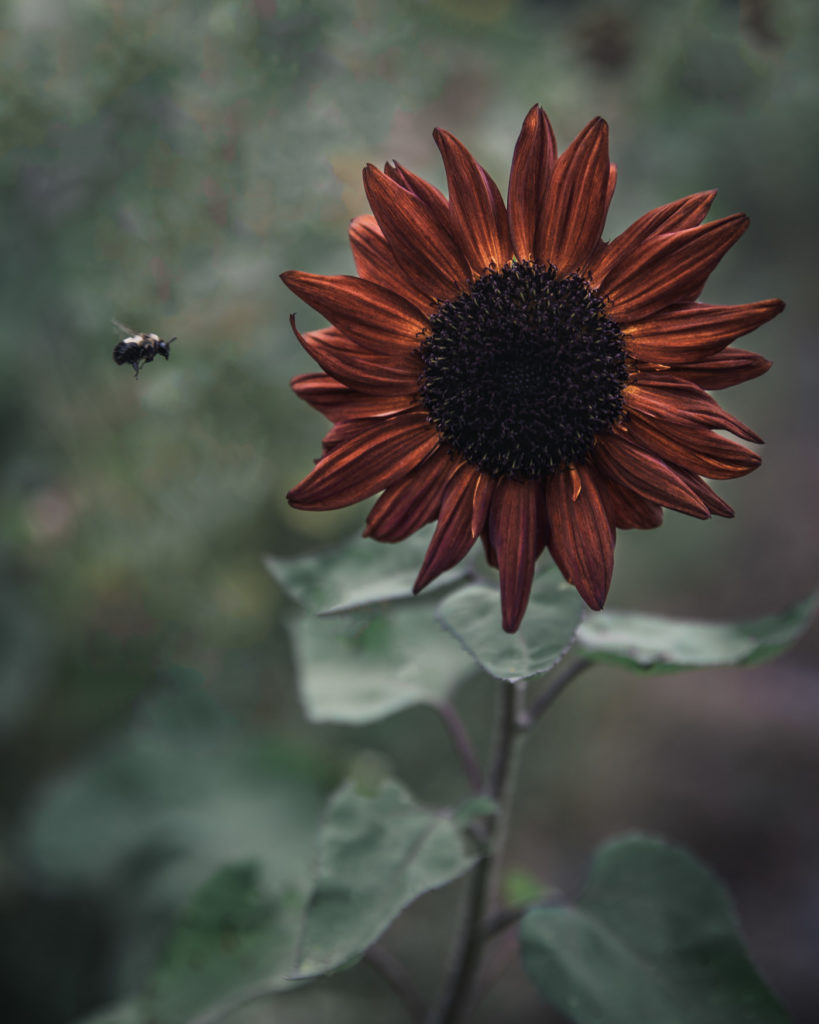
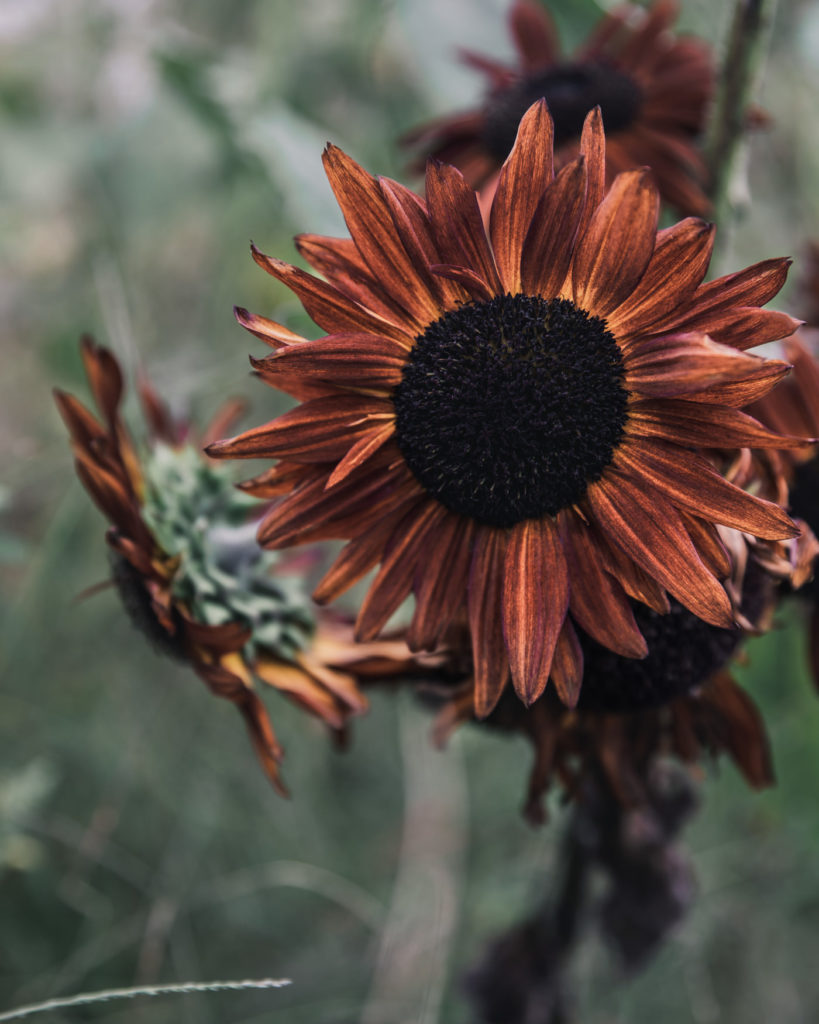
Pricing: N&B
February 14, 2023, USDA Boston Terminal prices for sunflowers are currently:
SUNFLOWER: MARKET STEADY. bunched 5s CA long 6.50-8.50 mostly 7.50 CD long 9.50 EC long 6.50-7.50 mostly 6.50 NENG long 6.50-7.50 mostly 7.50 NJ long 7.50-8.50 mostly 7.50 PA long 6.50 PE long 6.50 bunched 10s CA long 12.50 CD long 12.50 CT long 8.50 EC long 10.00 Miniature Type long 9.50 PA long 8.00-9.00 per stem CA long 1.25 CD long 1.50 EC long 1.00-1.25 mostly 1.25 NENG long 1.00-1.25 mostly 1.25 NJ long 1.00 NL long 1.00 PE long 1.00
The American Society of Horticulture conducted research to study the marketability of cut sunflowers to wholesale and retail florists and consumers:
Stems were harvested and shown to local floral wholesalers/retailers who were individually interviewed on their perceptions of the cut flower as a product. Farmers’ market patrons were administered a quantitative survey to determine their perspectives on locally sourced products and willingness to pay (WTP) for the specialty cut flower (SCF). Results indicated half of the local florists interviewed responded positively to locally grown floral products in general, with all florists willing to pay at the least the same amount for the SCF as they are currently paying for their standard commercially grown, imported cut sunflowers. Farmers’ market customers expressed a WTP of $1.34/stem and/or $10.13/bunch of 10 stems for the SCF with participants who expressed a higher concern for sourcing local products often more willing to pay a higher price for the SCF.
Pricing: BTS
During the 2022 season, we offered sunflowers by the bunch (10 stems) for local pickup at 5 different business locations in our area ($20) or for delivery on Fridays, limited to certain ZIP codes on our route ($30). In 2022, our price / stem was $1.50 to florists. It’s not unusual for me to throw an extra stem or two in, just FYI. I don’t see these prices changing for 2023.
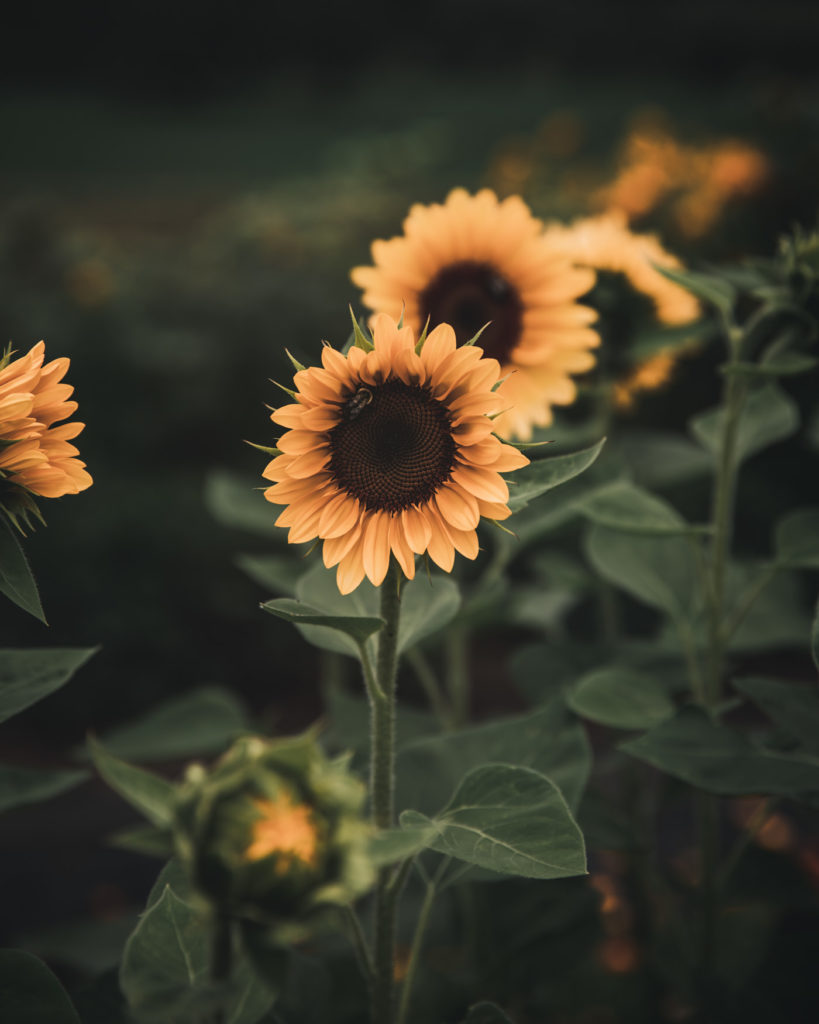
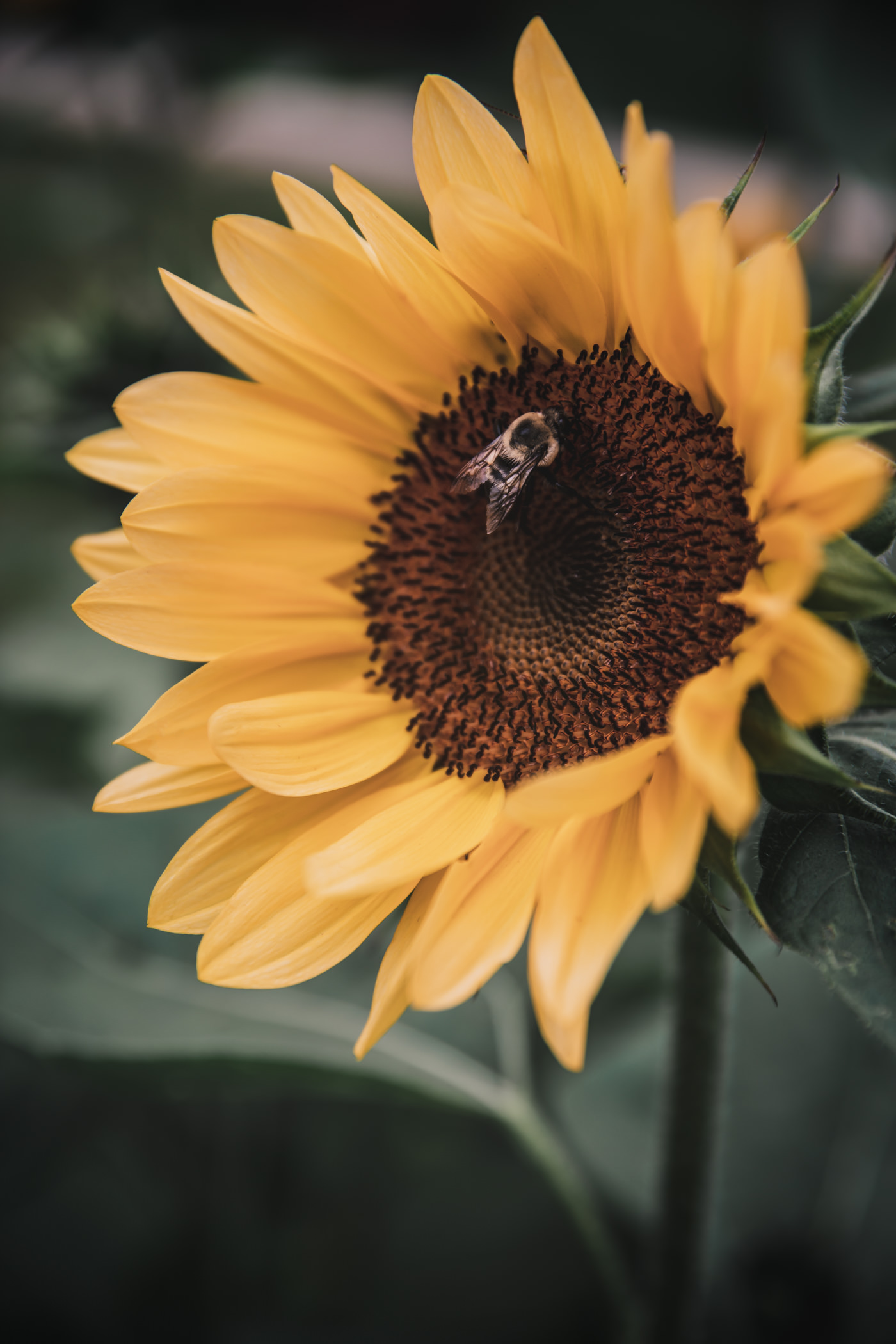

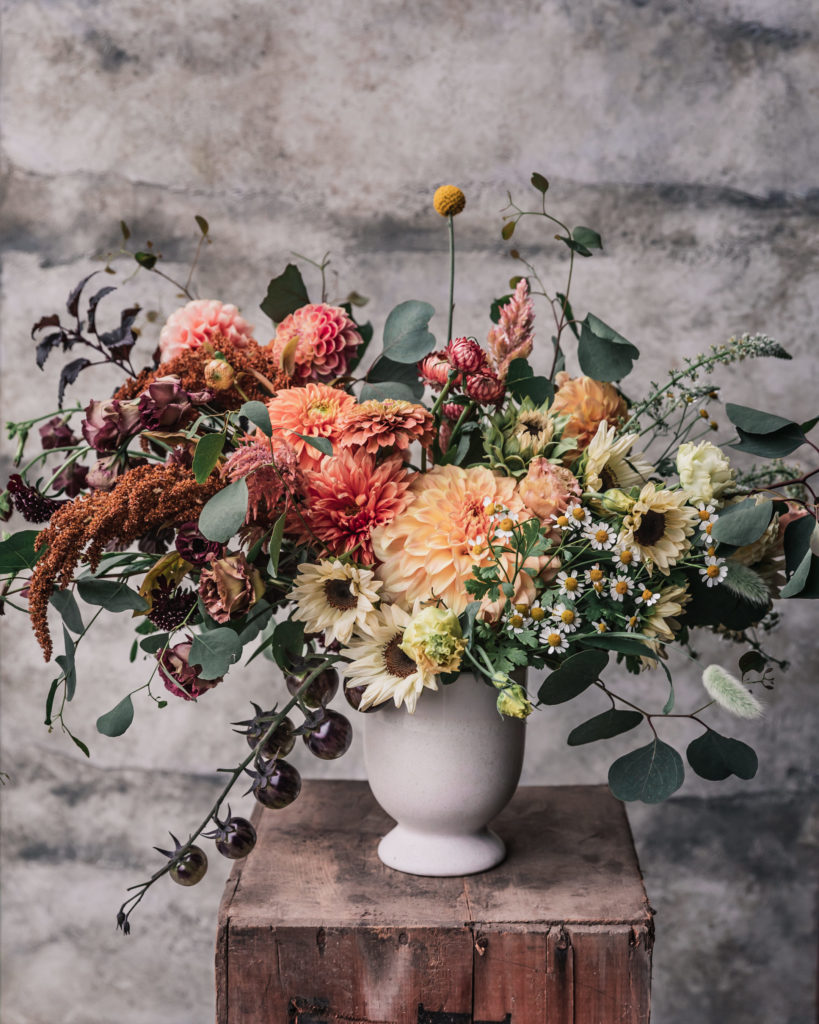
Design & Planning Color Palette: BTS Only
When I plan my successions, I’m usually aiming for lighter/brighter colors for summer (White Lite, Gold Lite, doubles) into more-classic and moody hues for fall (like ProCut Orange and ProCut Red). I love softer palettes, so I grow a lot of White Lite (our customers love her too).
In fall, I love a classic sunny, but I also love a moody spin. While ProCut Orange is a great classic sunflower (one I like to bunch with ProCut Red in the fall), I fell in love with ProCut Peach in 2022. I know it’s named “Peach” but to me it’s like a classic sunflower, but a little more vintage-y? with slightly lighter/warmer petals. Granted, my only photos of “peach” were taken on a super overcast and stormy day, so these photos are quite moody, but google ProCut Peach if you want to see other photos.
For more of an elevated fall moody spin, I like to bunch ProCut White Nite, ProCut Plum, and ProCut Red. I also love ProCut White Nite and ProCut Plum at the end of fall for moody market bouquets with lots of textural elements and fall hues.
Also: I, for one, do not think that sunflowers are limited to bunches and market bouquets! Yes, they are super cheerful and wonderful for those purposes. But I actually think they can be moody, dramatic, and even used for elevated design work (especially when small IMO). For example, I love ProCut Plum with blush and berry hues (goes so well with Lisianthus Brown and Light Apricot). Some of my favorites are: ProCut White Lite, ProCut White Nite, ProCut Plum, ProCut Red, Black Beaty, Cherry Rose, Ruby Eclipse, and Terracotta.
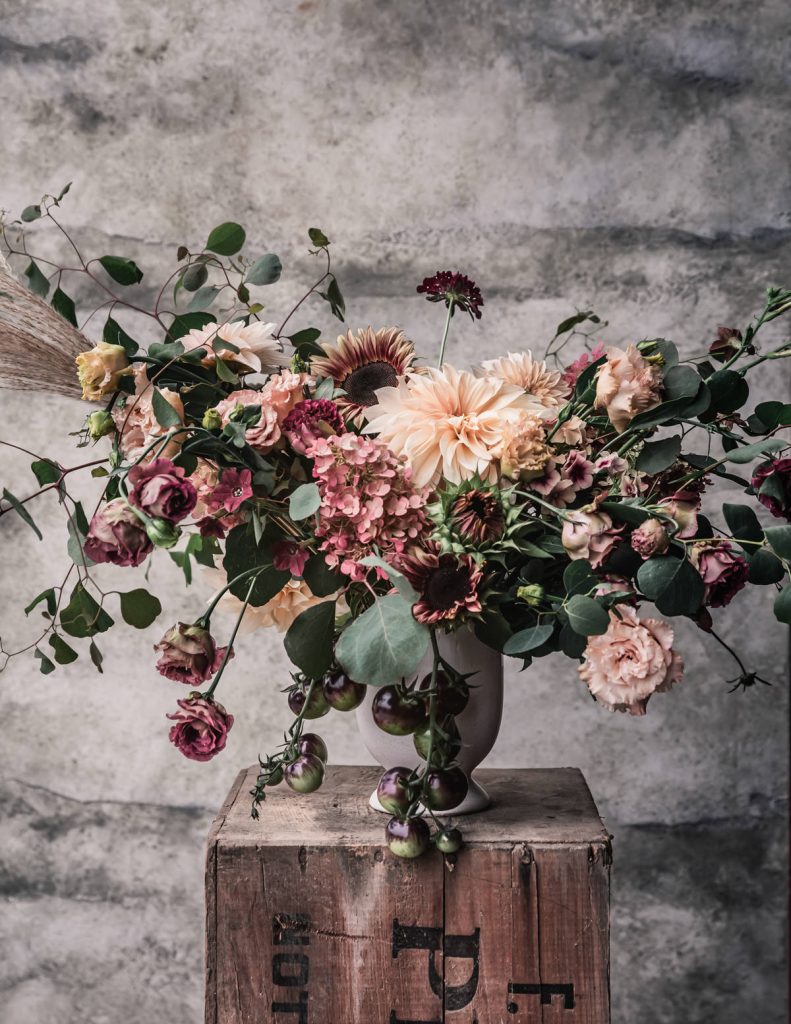
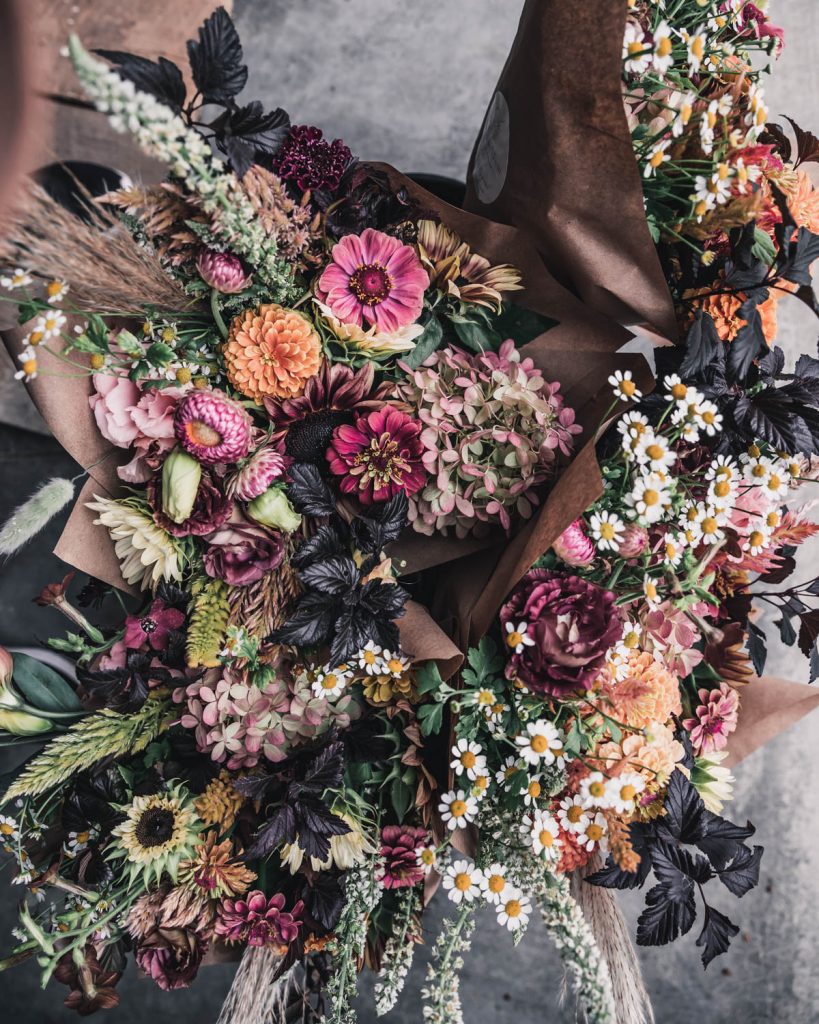
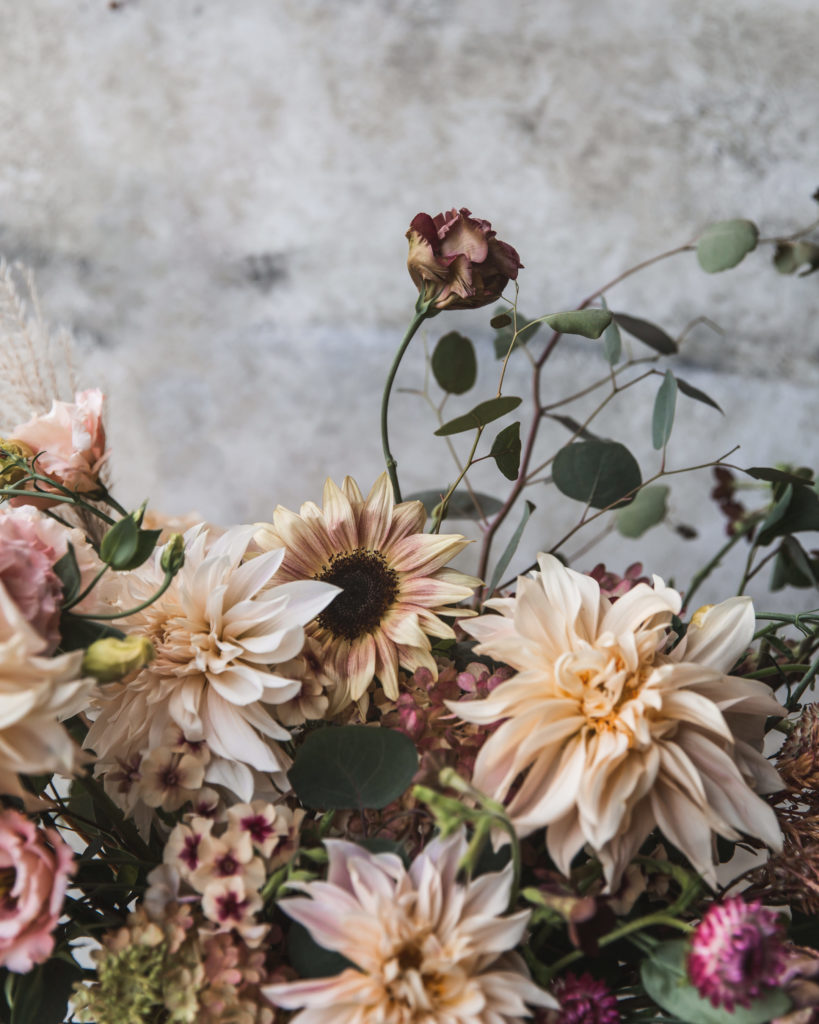
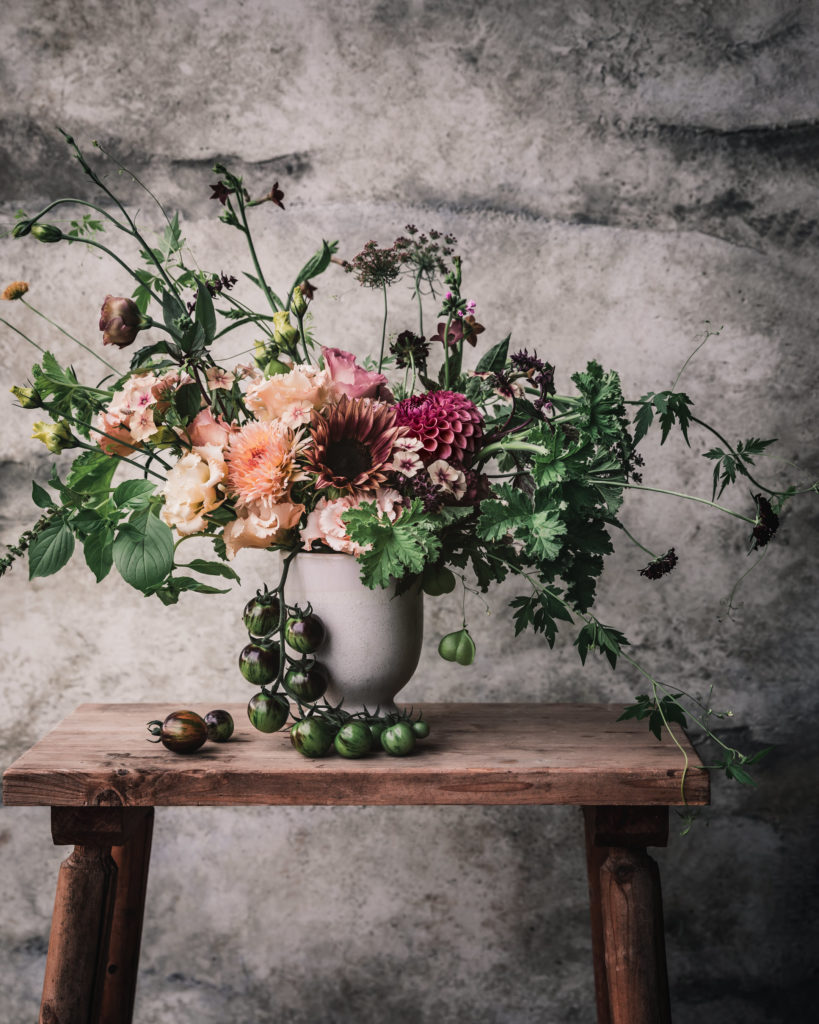
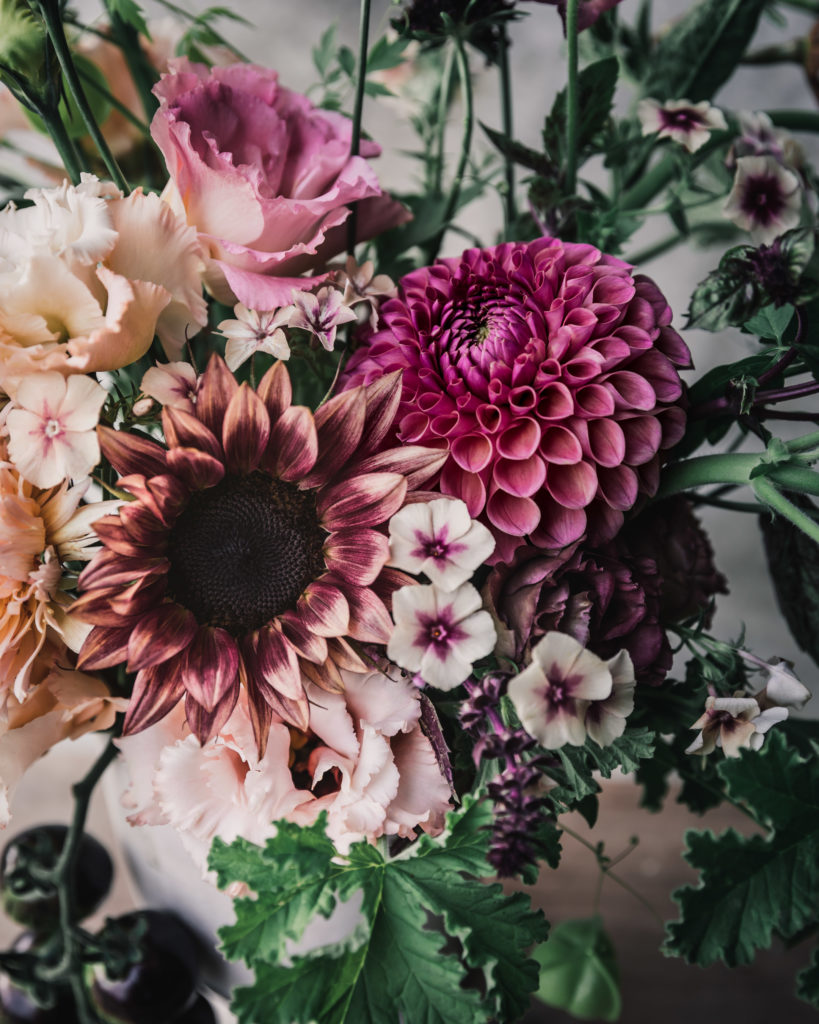
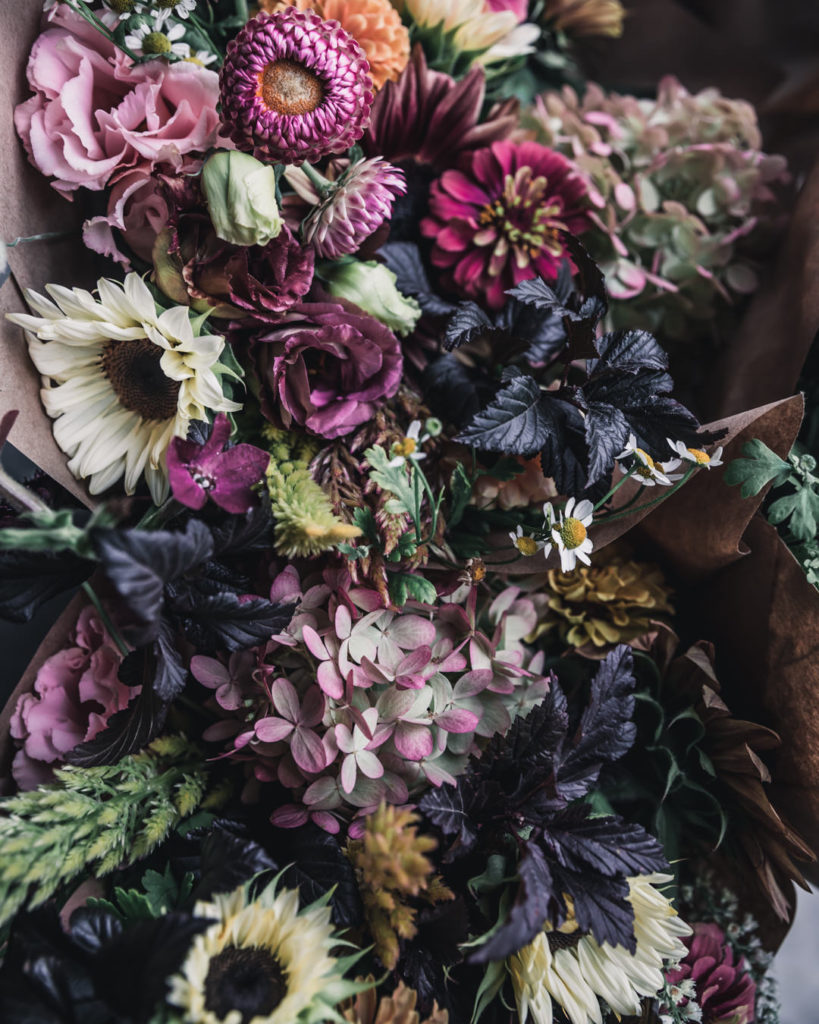
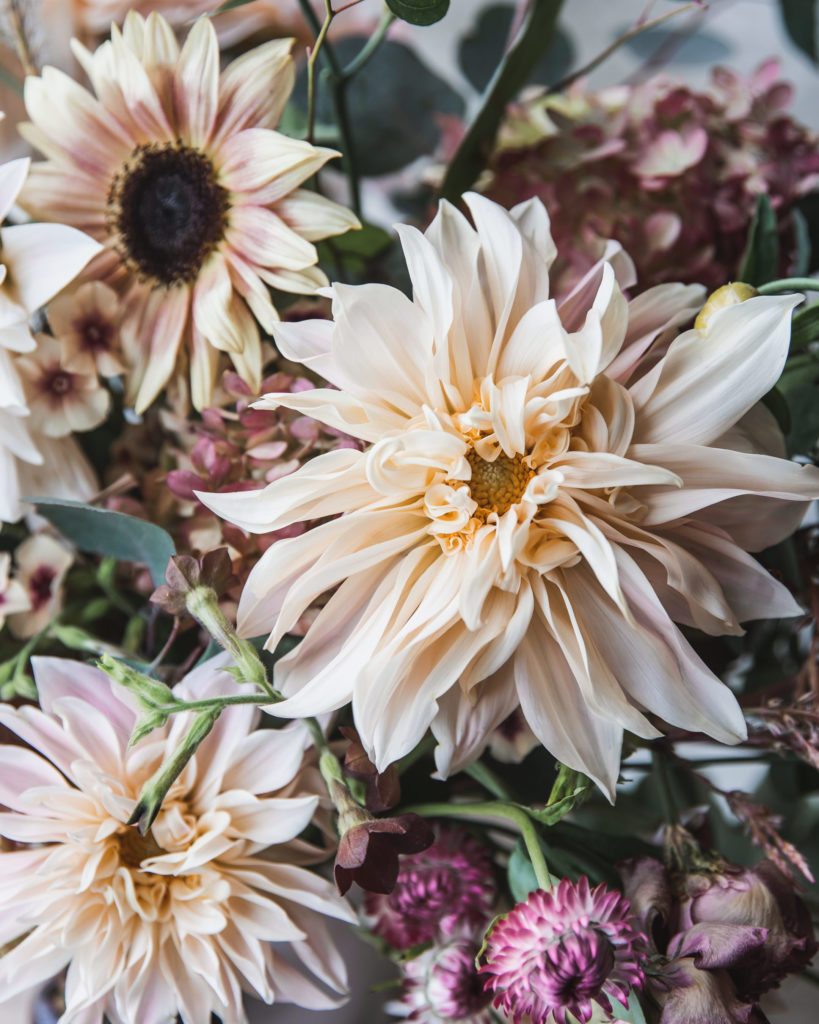
Wrap Up
OK, my friend, that is IT for February’s Plant Profile. What do you think? Can you see the potential for sunflowers?
Is there anything that’s unclear or you wish I would have covered? Or is your head spinning? No worries, this link will be live until the end of March, at which point you’ll get a PDF copy, so you can always refer back to it. Tip: use the find shortcut (Ctrl+F on a PC or Command+F on a Mac to search for any word or term).
Have any questions or something you want to share with me or others? I know I say this ad nauseam, but I truly believe in the power of the collective and that we all have something unique and powerful to share, so please leave a question or share a comment below. We’re all better for it, and I thank you in advance!
Cheers pal!
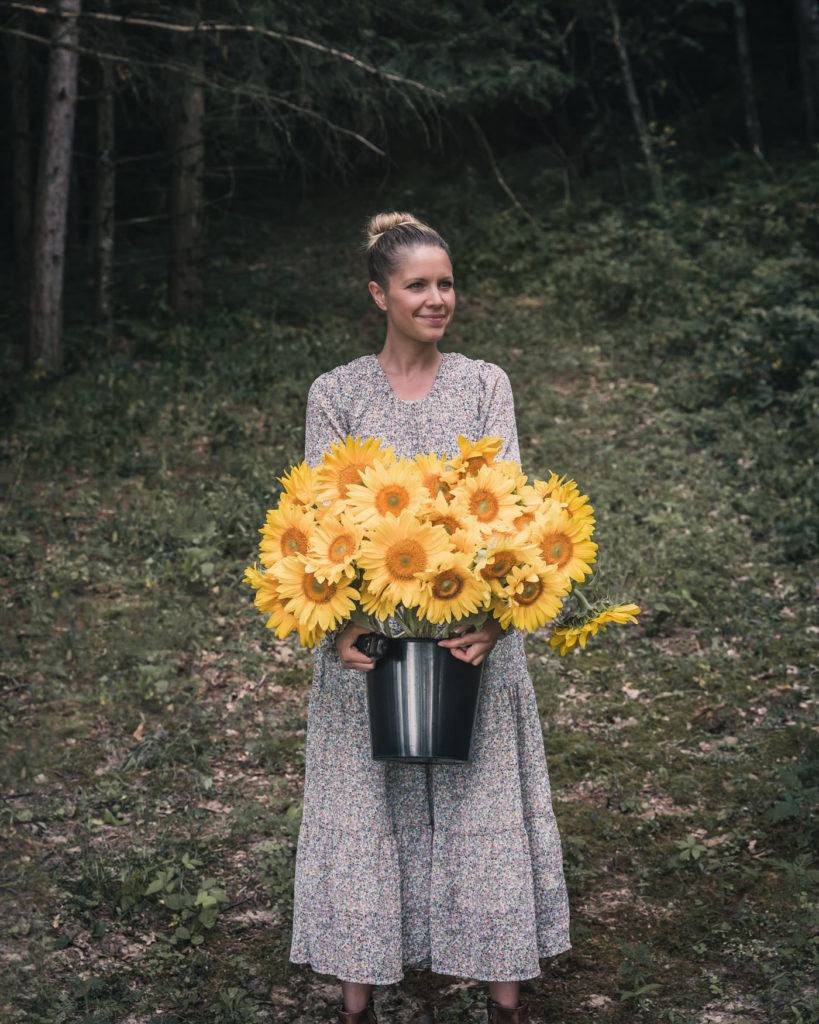
Your photos are just stunning! I am excited to use your tips and tricks for my sunflowers this year. I just took a quick glance at my sunflower seed packets and noticed they don’t really say if they are single stem or branching (have gotten the packs from a few different places). For a newbie still becoming familiar with the varieties, if Google a safe bet for searching if a variety is branching or single stem?
Kaylee, so kind of you to say, thank you!! I am sure your sunnies will be a smashing success. What I would do is check the website where you got them, they will likely say in the descriptions. If not, two trusted resources for me are Johnny’s and Sunflower Selections (you could search varieties there to verify). Finally, Google *should* be OK, maybe just try and verify/cross reference a few different sites. If you want to send me them, I can see which I know to be of what variety too!
Cheers, Maggie